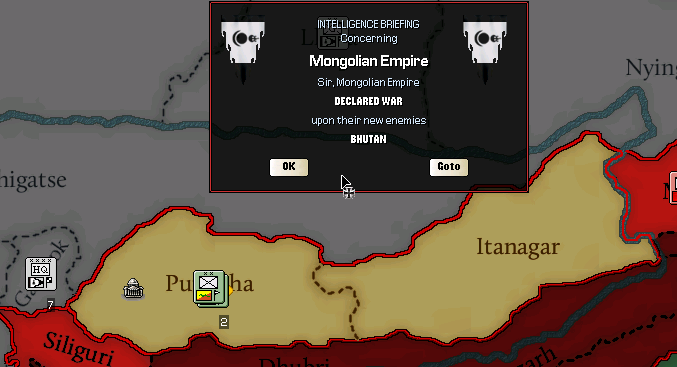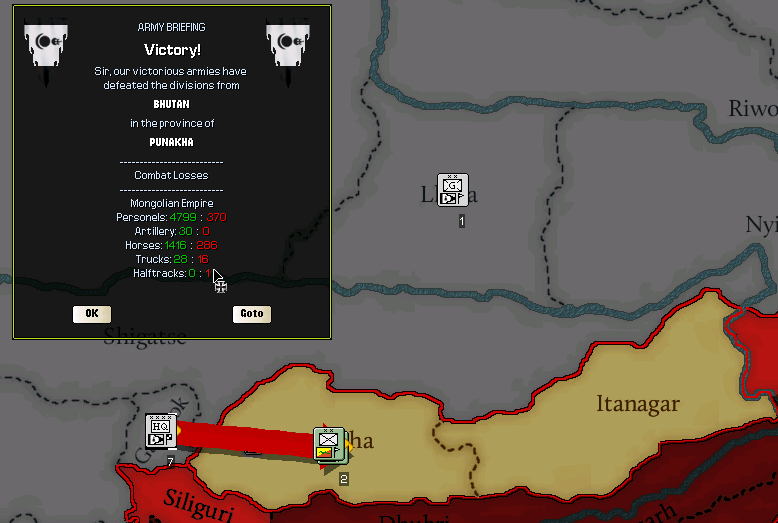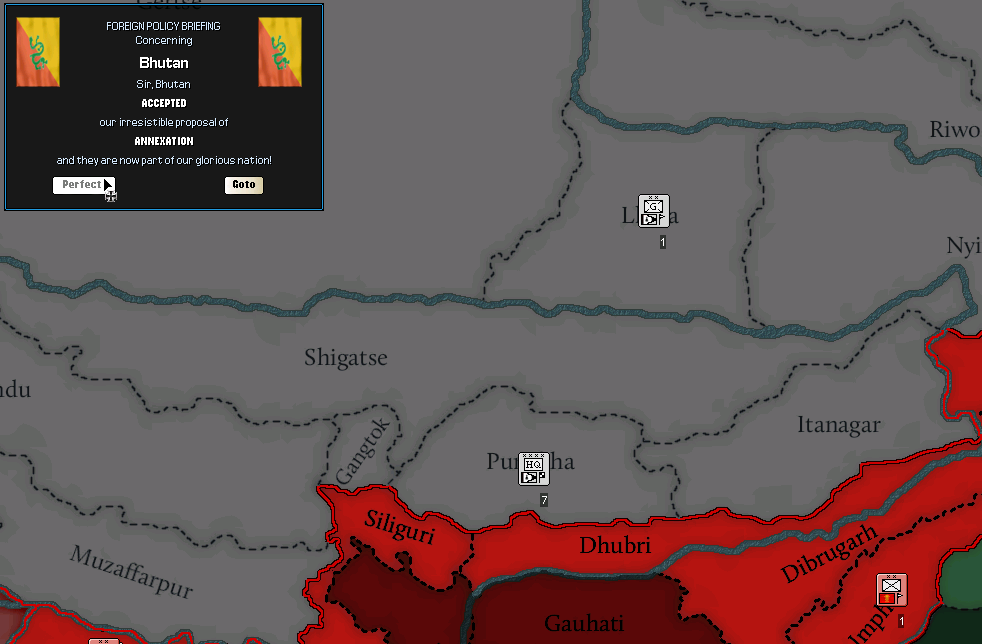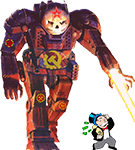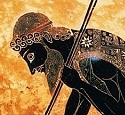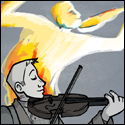|
Chief Savage Man posted:
Once more, the Dragon King of Bhutan shocks the world with a stupendous moral victory!
|
|
|
|

|
| # ? May 10, 2024 15:34 |
|
Could we have some maps, please? I want to see how large the Khanate is becoming
|
|
|
|
I rememember when I did a left SR Russia playthrough I ended up with Turkestan having conquered both Alsh Orda and Afghansitan, and then having it fallen to the Khan, turned out it was preety easy to take out the Khan.
|
|
|
|
The Khan clearly knows his ABCs. Always Be Conquering
|
|
|
|
I think I've played too much EU4 because I couldn't stop thinking about how much aggressive expansion the khan would be racking up. At this point Mongolia would probably be facing a coalition of everything single remaining state in Asia as well as Russia against them.
|
|
|
|
Vorpal Cat posted:I think I've played too much EU4 because I couldn't stop thinking about how much aggressive expansion the khan would be racking up. At this point Mongolia would probably be facing a coalition of everything single remaining state in Asia as well as Russia against them. Mongolia is, the coalition's members just don't know it yet.
|
|
|
|
CommissarMega posted:Could we have some maps, please? I want to see how large the Khanate is becoming Yes, please.
|
|
|
|
Okay then, let's do it. This is May 1939. The Khanate is gigantic. We are not at historical Kublai Khan levels but we're getting there.  Some interesting things around the world. The Netherlands went syndicalist and so their former government is in exile in Indonesia and allied to Japan. Basically it is Japan + puppets + Siam + Indonesia vs. Qing + Germany + Burma. Siam got wiped out pretty much.  The Ottoman Empire fell apart. The Arabs and Persians took what they wanted (Basrah is annoyingly still Turkish, that has to be an oversight), the Kurds are free, the Greeks took Cyprus and Turkey is now a republic.  The European war started in 1938 and the Internationale is kicking the poo poo out of Germany. Poland and Italy did not get involved and the non-AH Balkan states are not involved either, but other than the Internationale is pretty much everywhere.  The United States won the civil war and restored democracy. New England remains free and part of the Entente, while the USA is friendly but not part of it. Mexico is syndicalist, Brazil is Integralist, and that is about all that is interesting.
|
|
|
|
That France  . .I hope they're Totalists.
|
|
|
|
GrossMurpel posted:30 CAs are fine against a lot of enemy fleets but you're hosed if they have CVs. Nah, CVs are slower than modern CAs so they get caught and sunk easily. Just don't send anything slow - speed is everything in Darkest Hour naval combat. 30 CAs beat everything except a fleet of 15 BBs escorted by 15 CAs, and that fleet will die to subs or carriers. Gort fucked around with this message at 13:03 on Dec 19, 2014 |
|
|
|
So basically it's DH roshambo: CV fleet beats BB fleet, BB fleet beats CA fleet, CA fleet beats CV fleet?
|
|
|
|
Gort posted:Nah, CVs are slower than modern CAs so they get caught and sunk easily. Just don't send anything slow - speed is everything in Darkest Hour naval combat. Except I attacked a fleet that had like 5 CVs and they sunk half my CAs. Littlefinger posted:So basically it's DH roshambo: CV fleet beats BB fleet, BB fleet beats CA fleet, CA fleet beats CV fleet? I certainly haven't ever had my CV fleet beaten. They never get hit by anything except other CVs due to range, I dunno what Gort is talking about. I mean it, they literally don't suffer a single equipment casualty in most battles. GrossMurpel fucked around with this message at 13:18 on Dec 19, 2014 |
|
|
|
Here's the post I made on the matter on the Paradox forums a couple of years back: I decided to try out a theory of mine ever since heavy cruisers became screens rather than capital ships - an all-heavy-cruiser fleet! I noticed in particular that a heavy cruiser is faster than an aircraft carrier, and it's my understanding that whoever is faster gets to engage at the range of their choice. Germany has their submarines, so I decided to try out my idea against the US Navy as Japan. Japan starts good cruiser tech, so my fleet consisted of thirty 1934-tech heavy cruisers, with torpedoes, fire controls and floatplanes (to give them more than 1 sub attack). The resulting ship looks like this:  Now, I don't mind saying, building 30 of these babies while at war with China was no picnic, it took me until about 1942 to finish conquering China as a result. However, I did manage it, and launched the attack on Pearl Harbour on time. I set about conquering the Dutch East Indies, when my fleet was engaged by a mess of a US fleet:  Some older battleships, some newer ones, some pretty much brand new aircraft carriers, and an assortment of screens. The results were encouraging to say the least!  The entire enemy fleet was destroyed in four hours. I've also had other results, like convoy raids that destroy 33 transports and 4 escorts. I'm looking forward to engaging some submarines next. Oh, speak of the devil, during the invasion of Guam my fleet was engaged by ten US submarines:  While not as devastating as they were versus the surface fleets, they acquit themselves well, doing some damage for no losses at all.  These things are beasts. I had a bit of a look at how the battle played out versus the submarines - range begins at 5km, but the very next hour it opened up to 34.2 km, and the cruisers could fire and the submarines couldn't. As a result, the submarines get knocked around a bunch and the cruisers take no damage.
|
|
|
|
Obviously in those tests I wasn't up against very good fleet compositions (a human player wouldn't be mixing carriers and battleships in the same fleet) but from what I know of the naval mechanics the faster fleet gets to set the engagement distance and given equal tech levels a heavy cruiser is faster than a carrier. The fact that human carrier fleets don't get scratched in AI engagements is a testament to how bad the AI is at building a fleet that can catch a carrier, it doesn't mean carriers can't be caught.
|
|
|
|
Gort posted:
Notice how the CVs are in range before anything else is. I guess you were lucky it was only 2 CVs.
|
|
|
|
GrossMurpel posted:Notice how the CVs are in range before anything else is. I guess you were lucky it was only 2 CVs. Yeah, that stops after the first hour and the CAs catch them. I'd load up a multiplayer game and test 30 CAs versus 15 CVs/15 DDs but I long ago stopped actively playing Darkest Hour in favour of fantasising about how good Hearts of Iron 4 will be.
|
|
|
|
GrossMurpel posted:Except I attacked a fleet that had like 5 CVs and they sunk half my CAs. I never play as huge naval powers, so I've never tried it myself, but I have heard that the ideal time to hit a CV fleet is when there is bad weather in the same sea zone. The planes can't take off so their utility is significantly hampered.
|
|
|
|
What if you used cruisers to protect carriers instead of destroyers. beefart posted:I never play as huge naval powers, so I've never tried it myself, but I have heard that the ideal time to hit a CV fleet is when there is bad weather in the same sea zone. The planes can't take off so their utility is significantly hampered. Due to the way the game simulates carrier aircraft groups as very long ranged turrets, swap "significantly hampered" to "completely useless" because carriers can only attack with their planes and bad weather disables CAG "turrets".
|
|
|
|
Part Five: May 1939-February 1940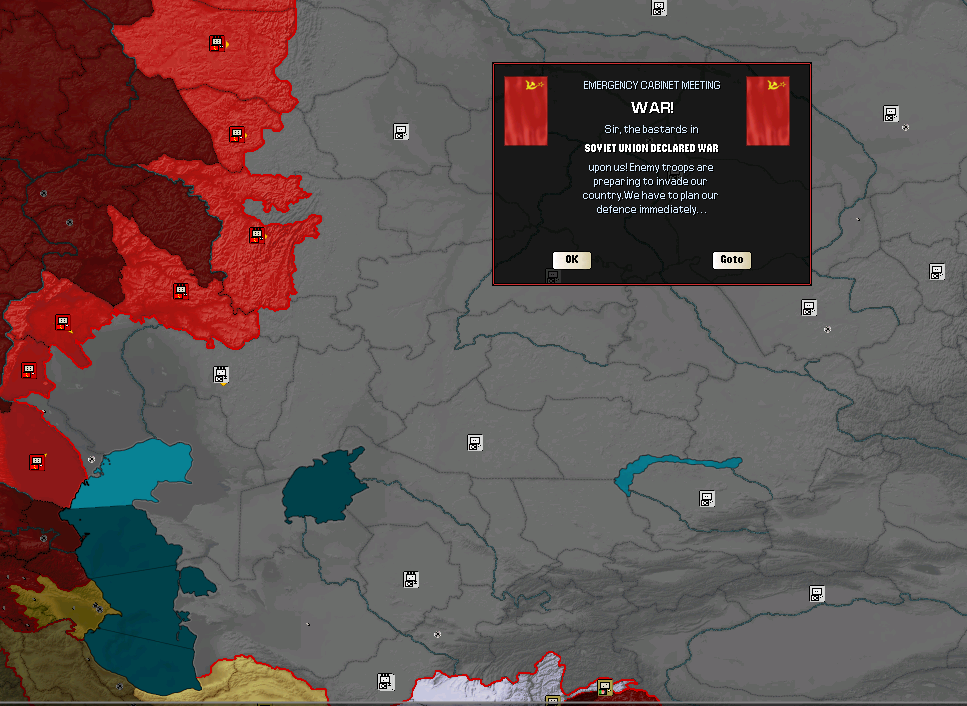 The clash between the Khan and the Reds was inevitable. It was always a matter of who was going to strike first. The Khan planned to undergo operations in Afghanistan and Persia before taking on the Reds, but the Reds struck before those operations could be carried out. 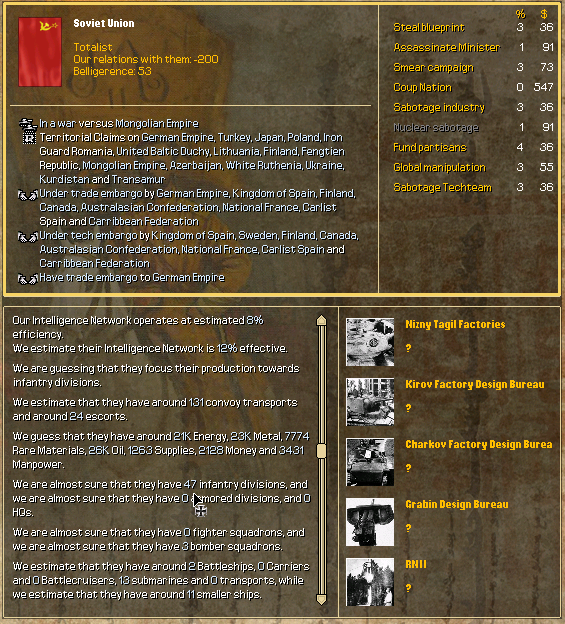 The newly declared Soviet Union was an industrially powerful nation with transcontinental ambitions. They were not an official member of the Internationale, as their Totalist ideology clashed with the Syndicalist orthodoxy of Paris. The Red Army was large, but had been fighting the Whites in a brutal civil war for years. Time would tell if that experience had exhausted them or prepared them well.  On paper, the Mongol army was only somewhat smaller. However almost half of the army were quickly trained garrison units that were not equipped for maneuver warfare. The backbone of the Mongol army was its nineteen cavalry divisions. 19 cavalry versus 47 infantry divisions. The Mongols would have to get creative. 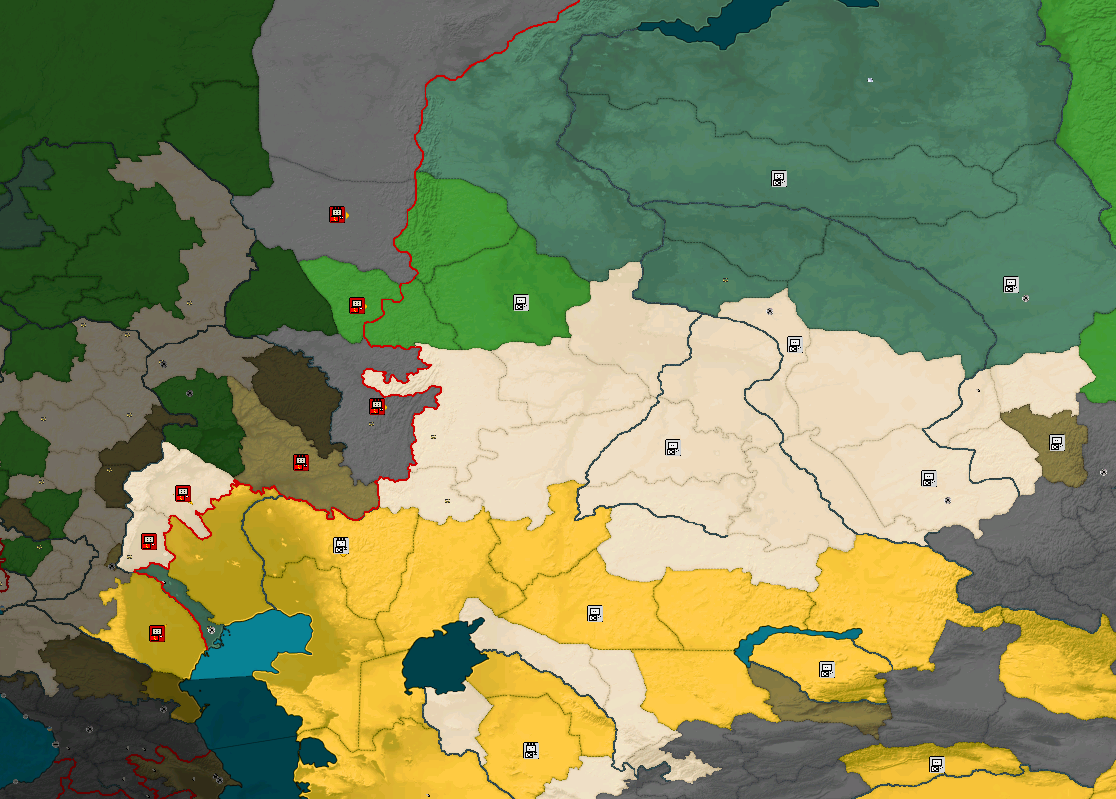 The mass infantry tactics of the Soviets had served them well in the cities and relatively dense areas of Russia proper. Beyond the Urals, the situation was quite different. The far north consisted of marshes and permafrost, which would prove very difficult for anybody to cross. The Central Asian deserts would be exhausting to any infantry forced to march across it in the heat of the summer. And the important corridor around the Trans-Siberian Railway was wide open plains, the perfect terrain for the Mongol cavalry.  The weather was also poor in some areas. The infamous rasputitsa was in full effect, leaving many roads unusable. This would also slow down the Soviet advance in places. 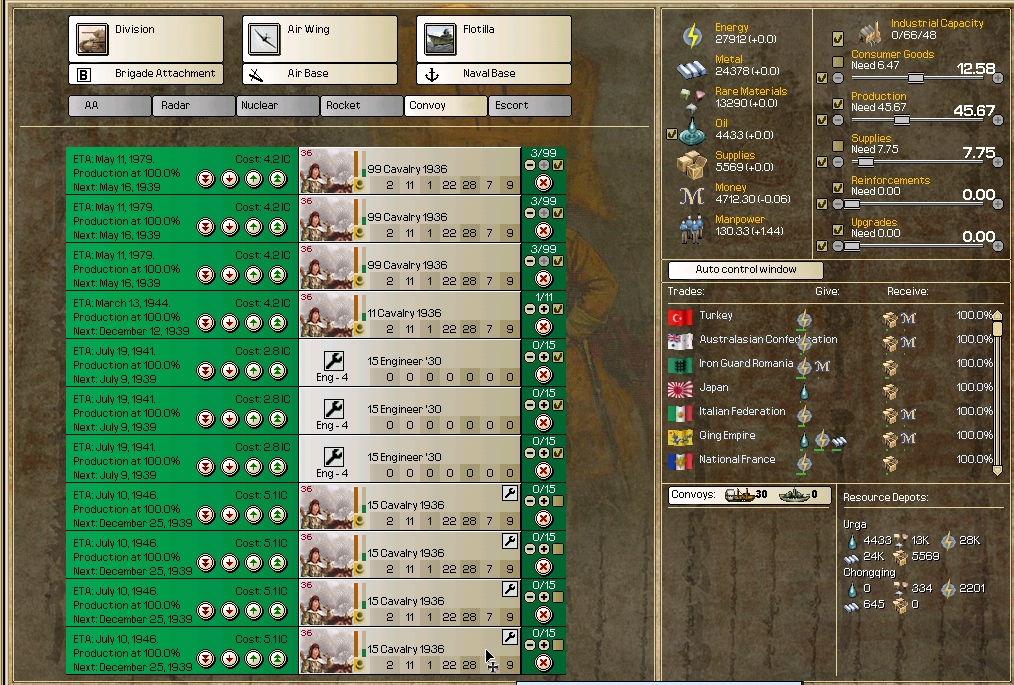 The Reds had a three to one advantage in divisions and this would need to be addressed if the Mongols were to go on the offensive, which would need to happen relatively quickly. The Soviet advantages in manpower and industrial capacity would eventually allow them to flood the entire front with large amounts of infantry give enough time. 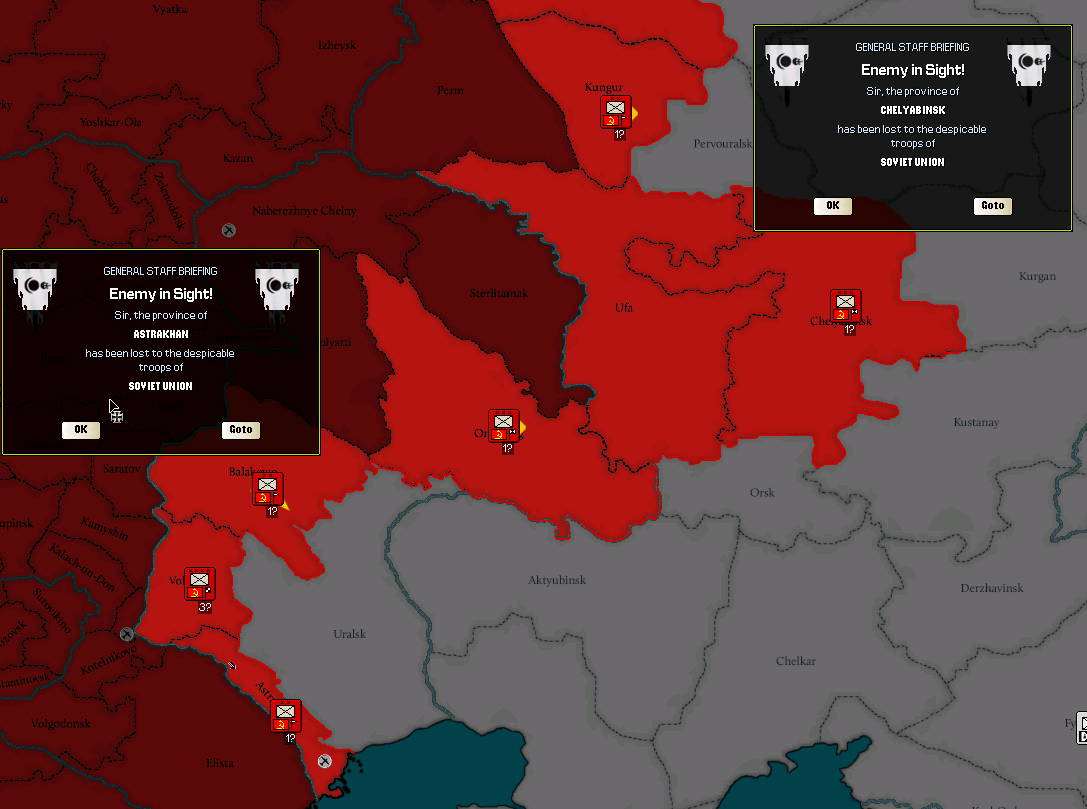 The one advantage the Mongols had is the advantage that they had had for centuries. Their horses allowed them to move and stay rested, while the Soviet infantry would need to undergo long exhausting marches. The Reds expected a ferocious enemy as they advanced. Instead they found nothing but abandoned outposts and hoofprints. 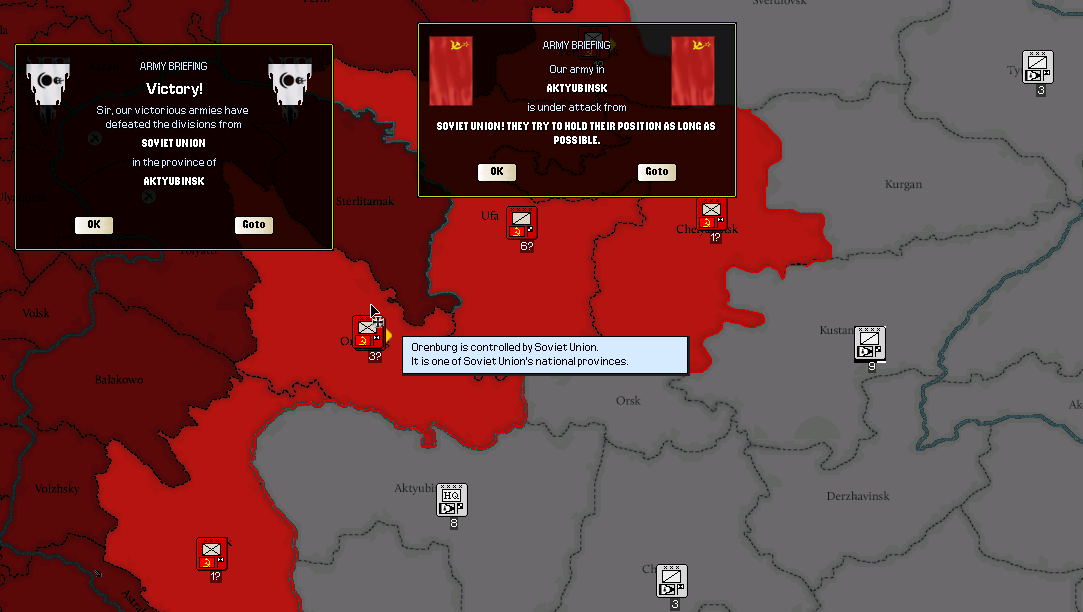 The Red Army moved from town to town without stopping through the heat and mud. Then suddenly, the Mongols appeared.  The far north had the smallest concentrations of Soviet troops. The Khan had spent a few years studying the 'Centre de Gravité' tactics pioneered by the leading French armored warfare theorists. The Khan adapted the tactics for cavalry. The weakest points were targeted, in the hopes of encircling the enemy. The Red Army would have to be cut down bit by bit in order for the Mongols to win. 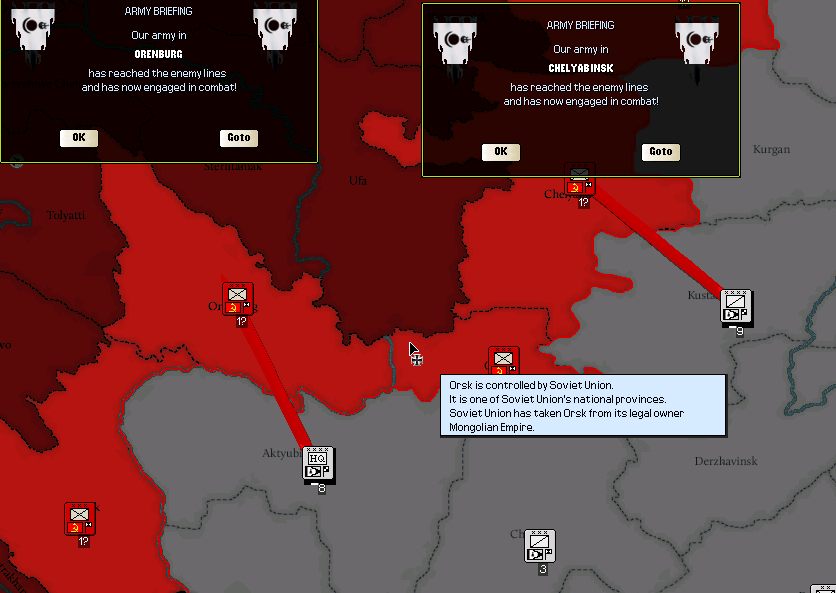 The two main hordes began a pincer movement with Orsk as the target. 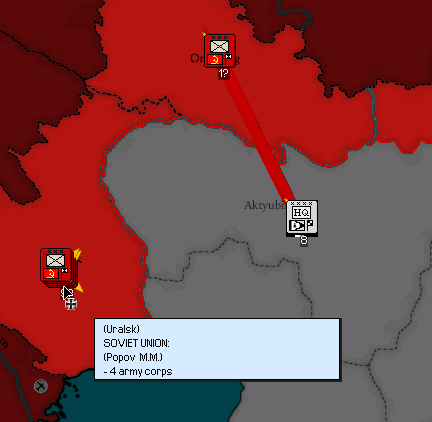 As the light defenses in Orenburg and Chelyabinsk fell, a larger concentration of Soviet troops began to come out of Astrakhan. They were seeking to flank the main Mongol concentration. 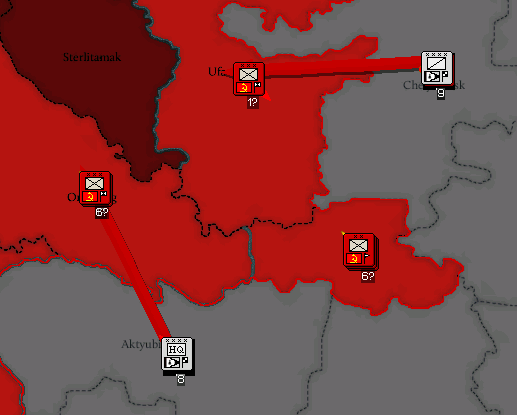 Chelyabinsk was recaptured quickly and the slow retreating Soviet infantry were unable to recover before they were set upon again. 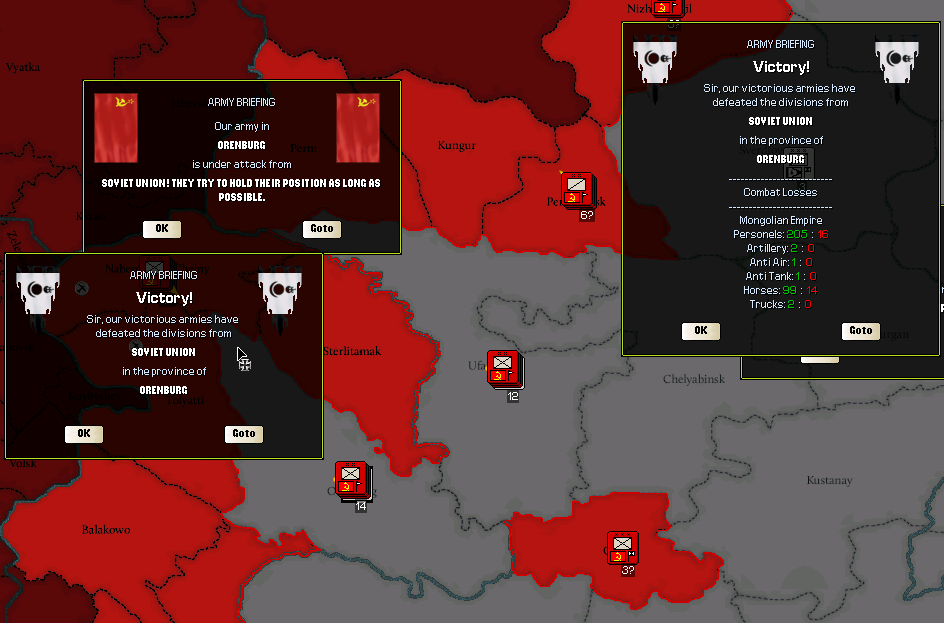 Ufa and Orenburg fell, and the jaws were shut. 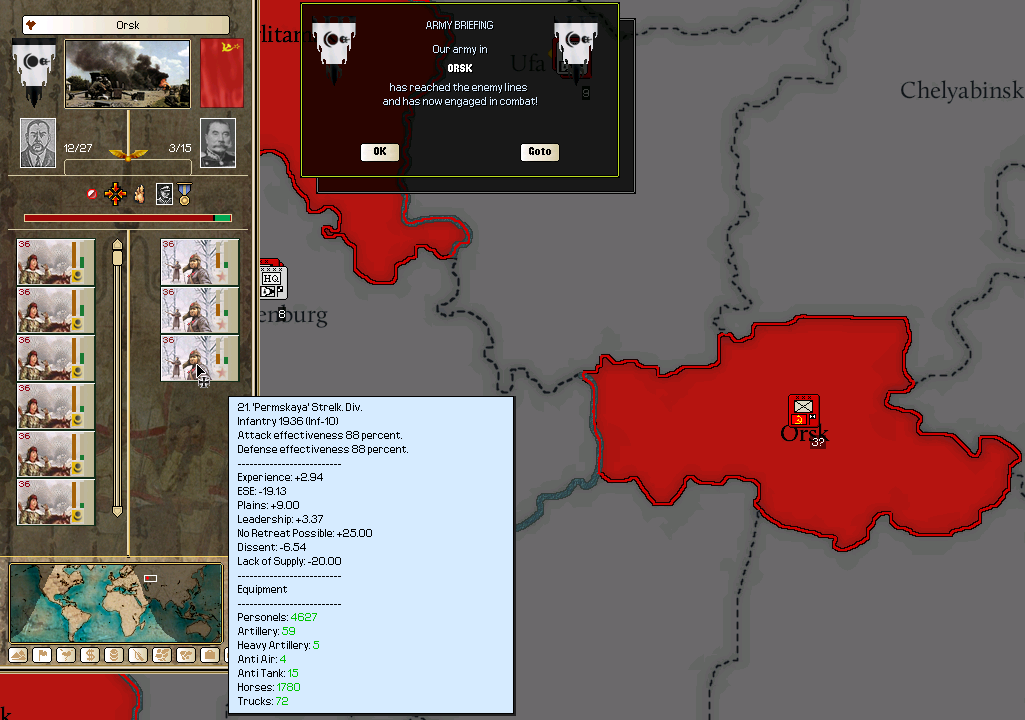 The Mongols knew from their intelligence that three Soviet divisions were trapped in Orsk. When they only accounted for fifteen thousand men, the realization settled in that many Red Army units were significantly understrength. Suddenly the Red Army did not seem like such a threat. 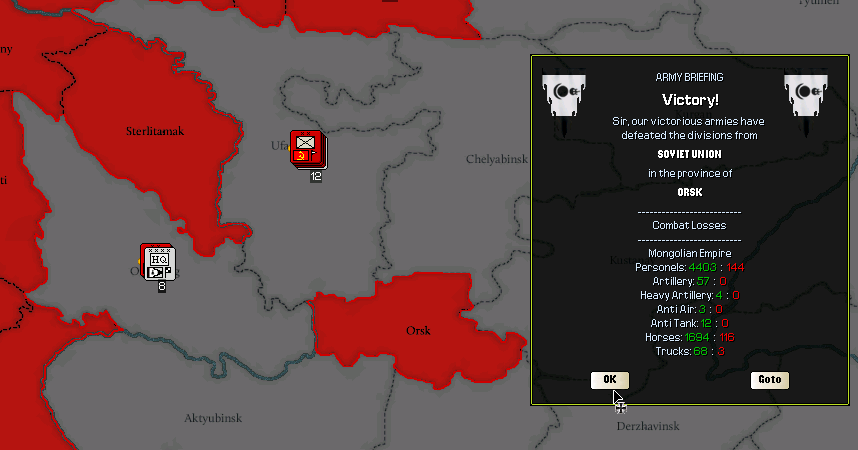 However many men were in each division, there were zero when the Mongols were done with them. Three divisions down. 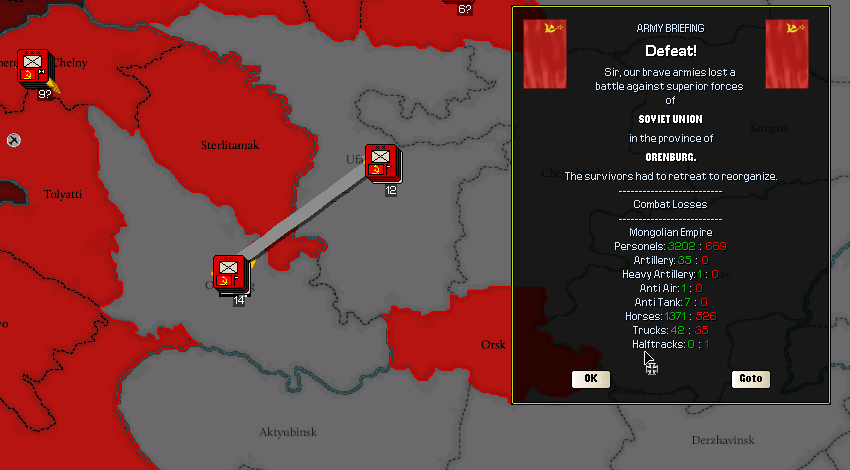 The southern pincer came under assault by a Soviet army from the northwest. Protracted battles were not desirable and so the unit retreated to group up with the northern pincer. Territory was just a means to killing the enemy. That is where the Soviets had made their greatest error in judgment. 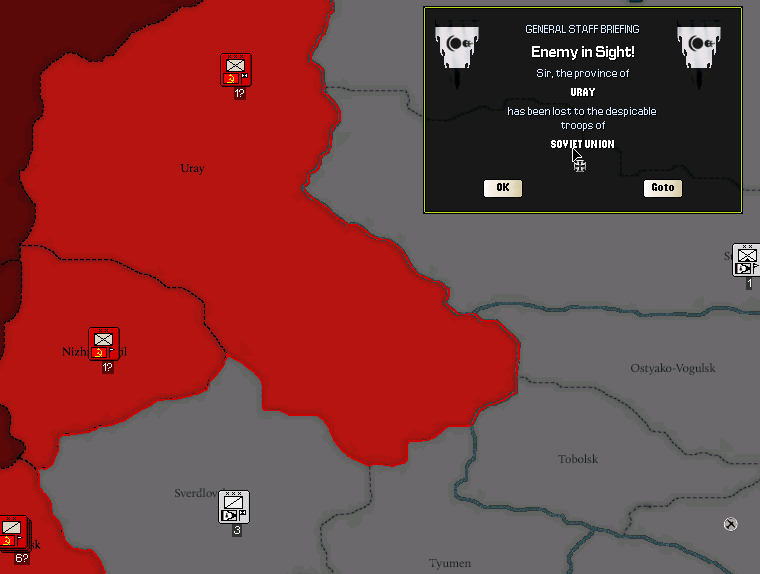 The Soviet advance into the far north was probably the best example of this. The Soviets were more concerned about being able to say they had captured territory while hiding the costs of that territory from the people. Uray brought no particular advantage to the Soviets. 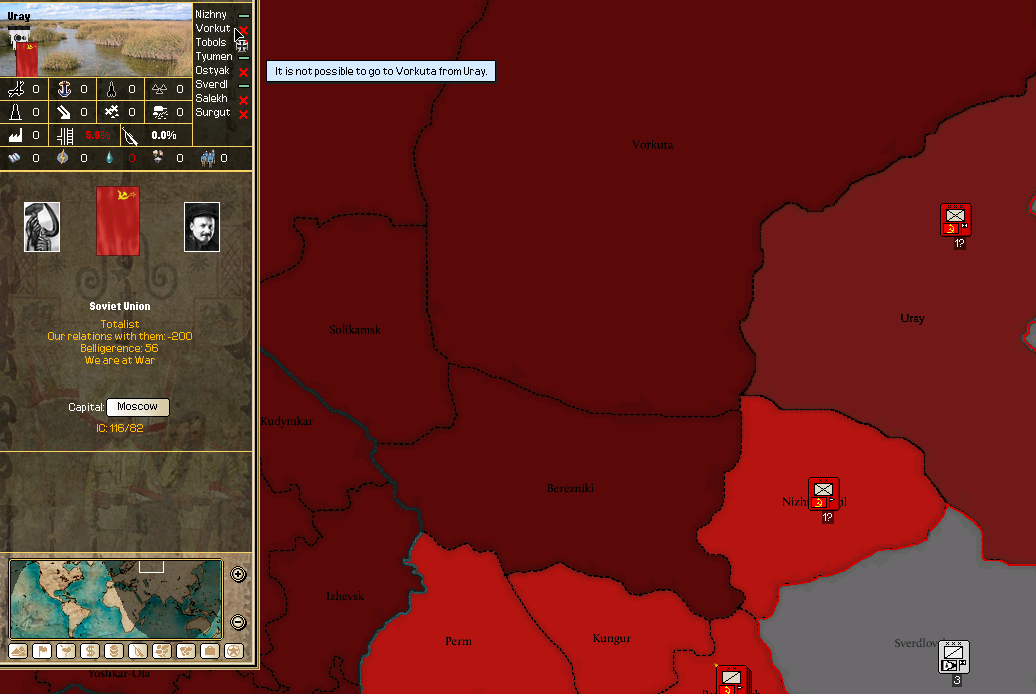 The long snaking route they had taken to get there did. The terrain between Uray and Vorkuta was impassable, leaving only one poorly maintained route to the south as their escape route. 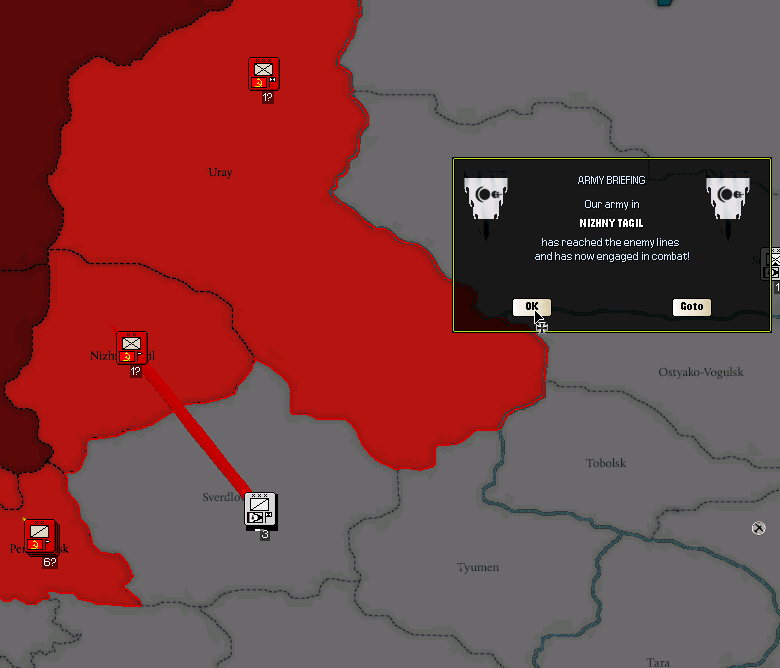 This was an opportunity. 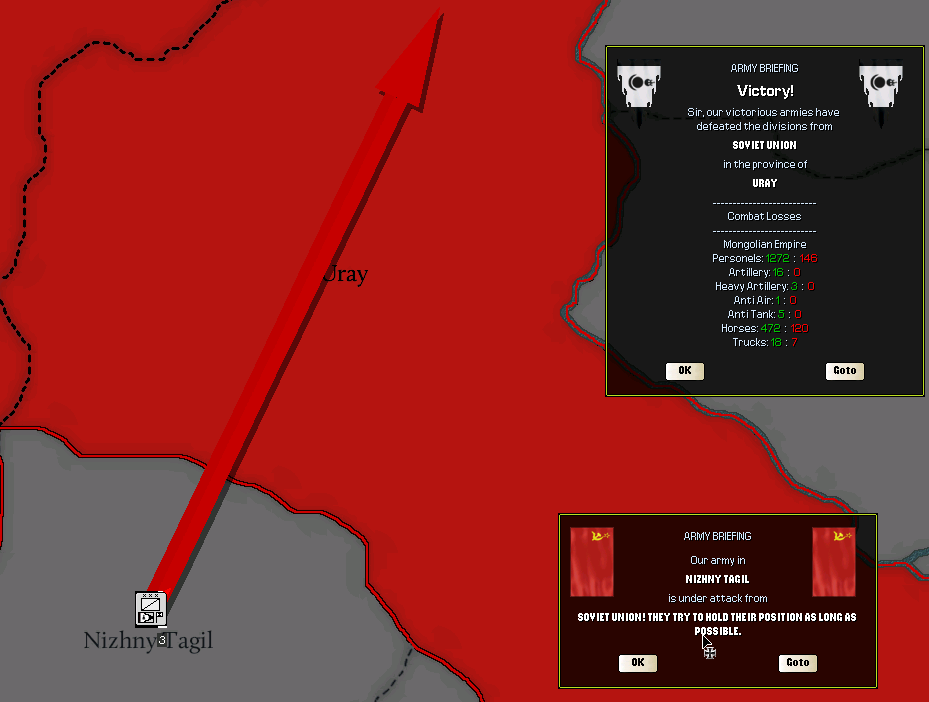 A full Soviet division perished in Uray. The Mongols did not bother to recapture the barren wasteland. 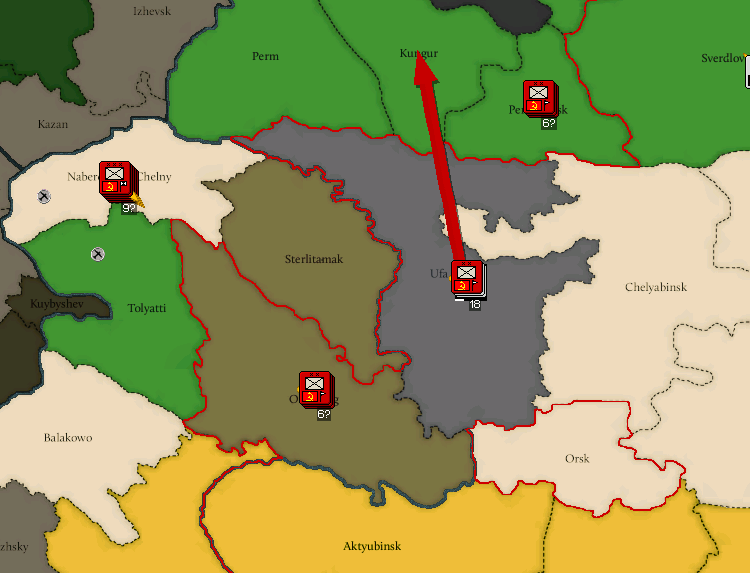 Ufa was built up around an old Tsarist fortress and the Mongols would use it for a similar purpose. Its rugged terrain was defensible and it allowed the hordes to strike in many different directions towards the Soviet units moving past it. There was risk of being cut off, but the prospect of destroying three, six or even nine Soviet divisions was worth the risk. 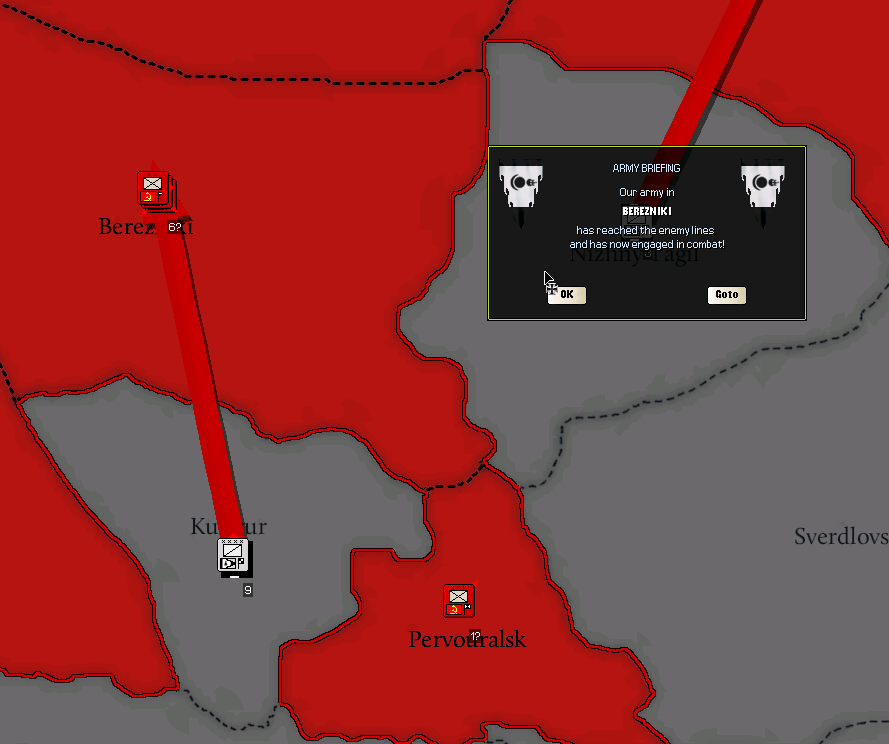 The Uray trap provided a synergistic opportunity as it also cut off an escape route for a division to the south. One of the main hordes struck north to cut them off completely. 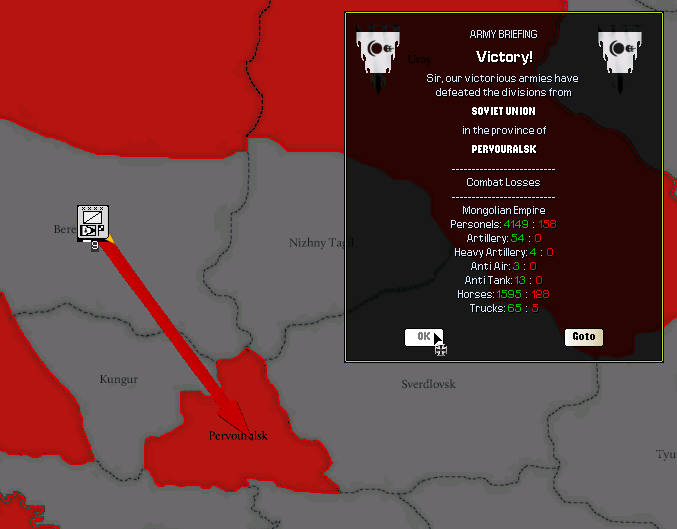 One more down. 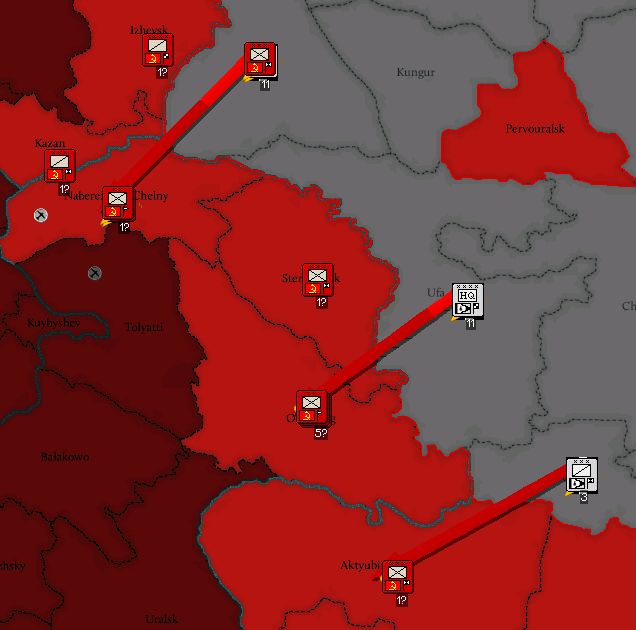 A large three pronged assault towards the Volga came next. There were encirclement opportunities to be had. 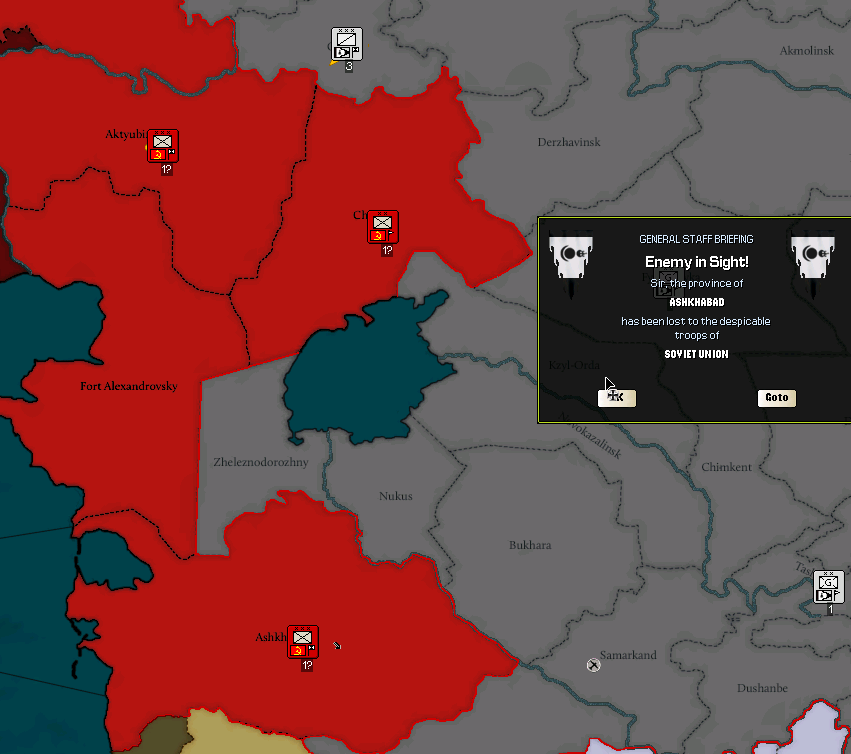 A smaller three-division horde was moving to the south. The Khan had so far ignored the Soviet intrusion into Central Asia. Their supply lines had gotten long and tenuous. 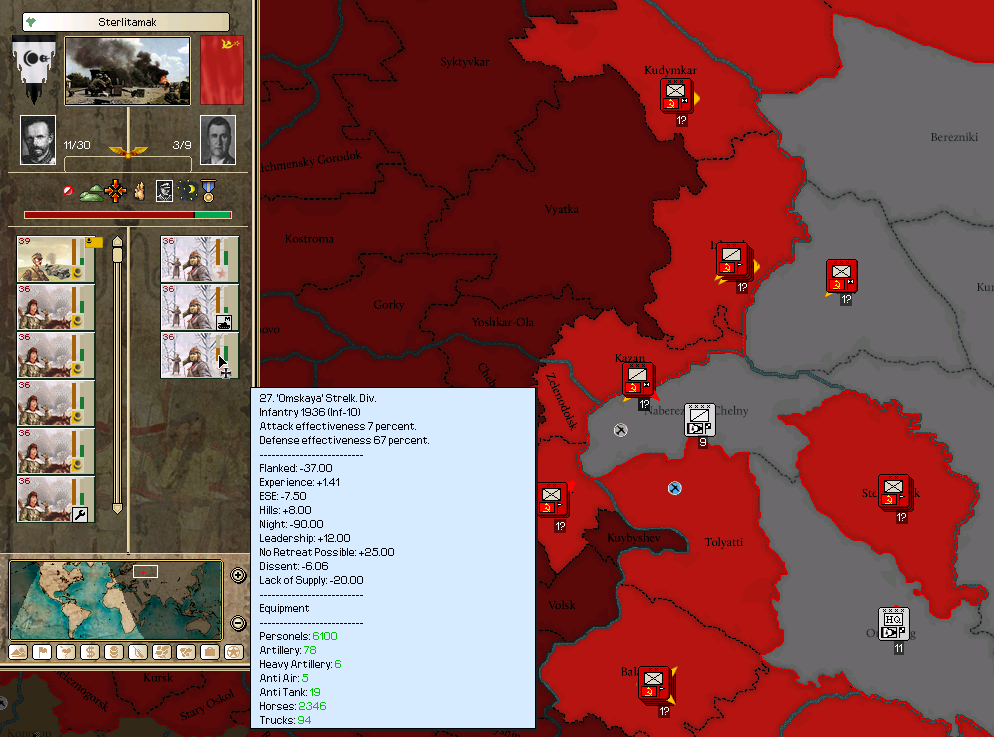 The two main hordes completed their pincer movement and trapped three Soviet divisions consisting of about twenty five thousand men, including a tank brigade. 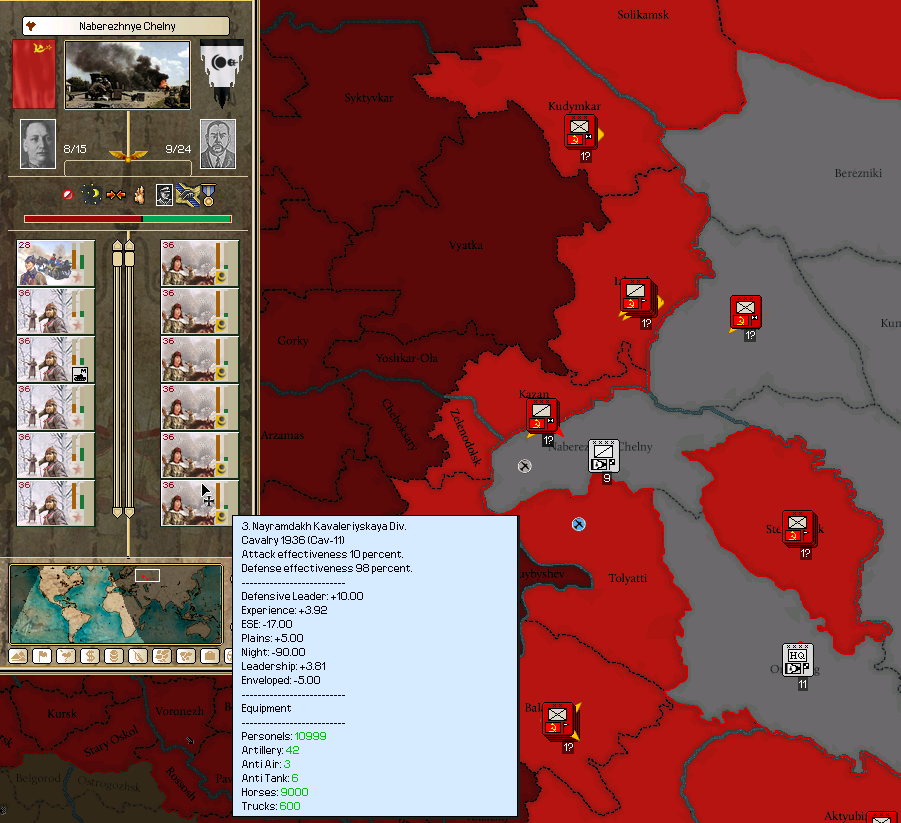 The Soviets made a great effort to break the encirclement. The hordes had moved rapidly and were getting tired. 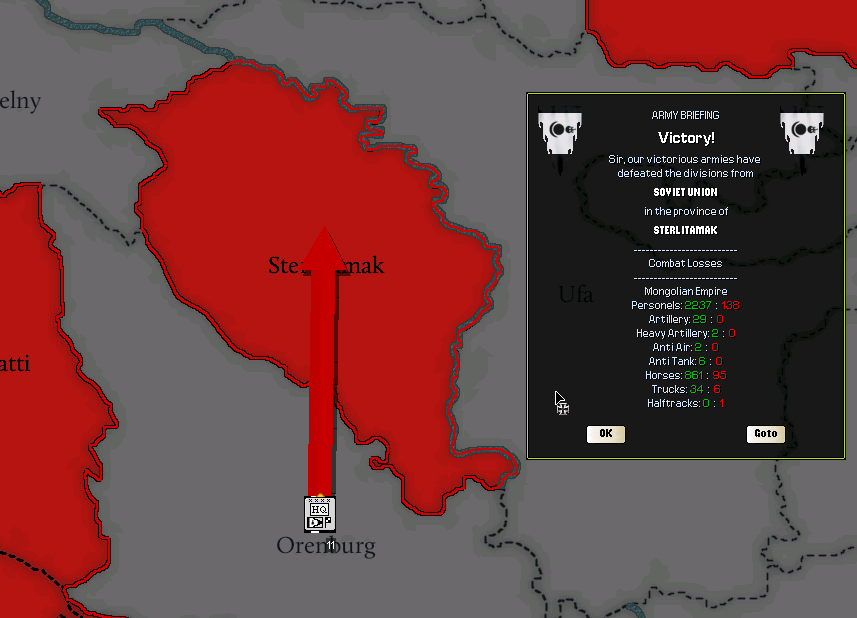 The Khan was able to take complete control of the operation while the other horde defended itself. Three divisions down. 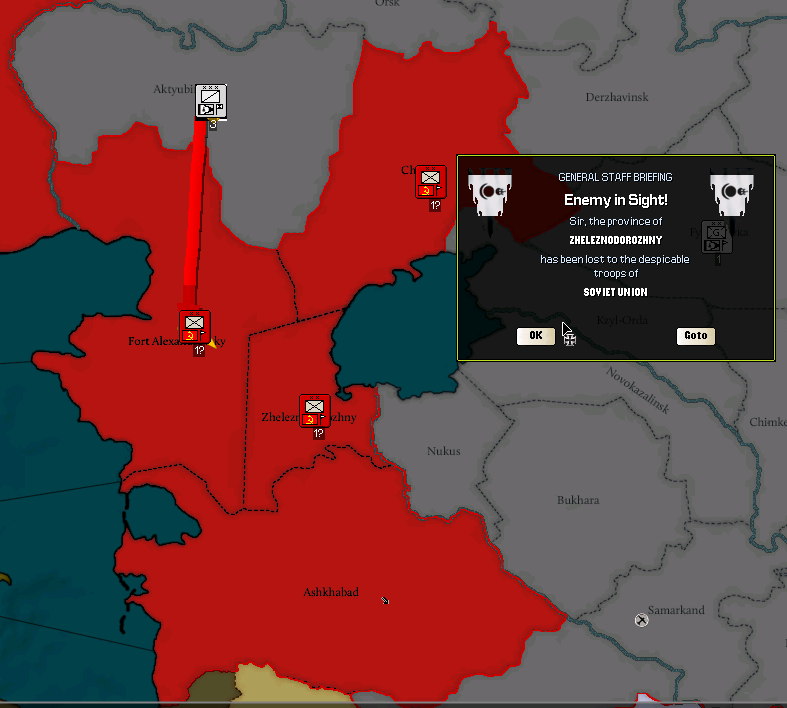 Three more divisions were moving through Central Asia. They were moving separately, trying to cover as much ground as possible. This would make it easier to take each one apart separately. 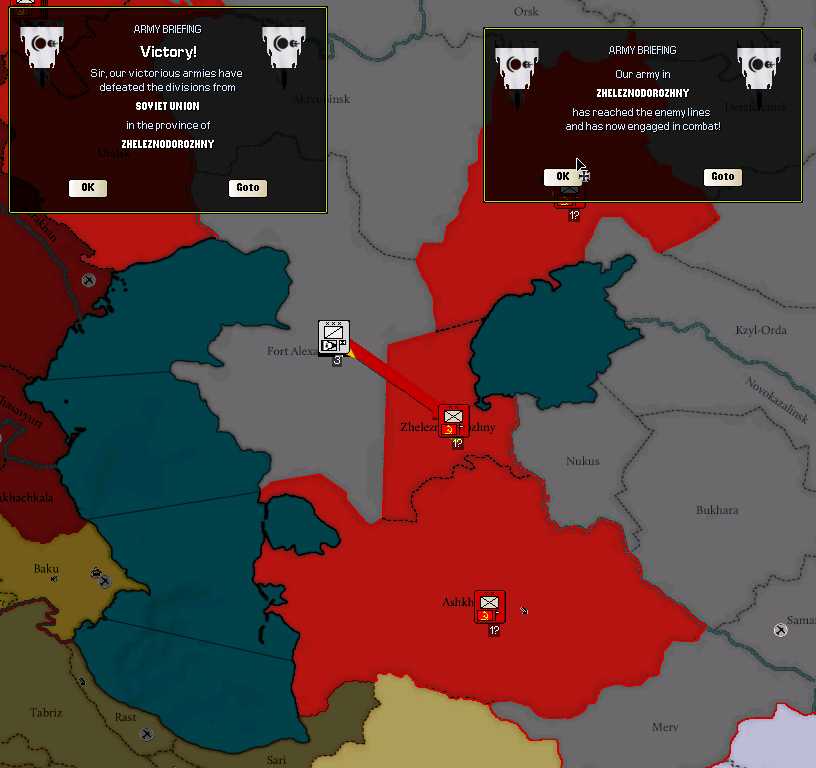 The Mongols reestablished contact with the Caspian Sea, cutting off the three divisions. The horde struck towards the center, looking to divide the pocket into two. 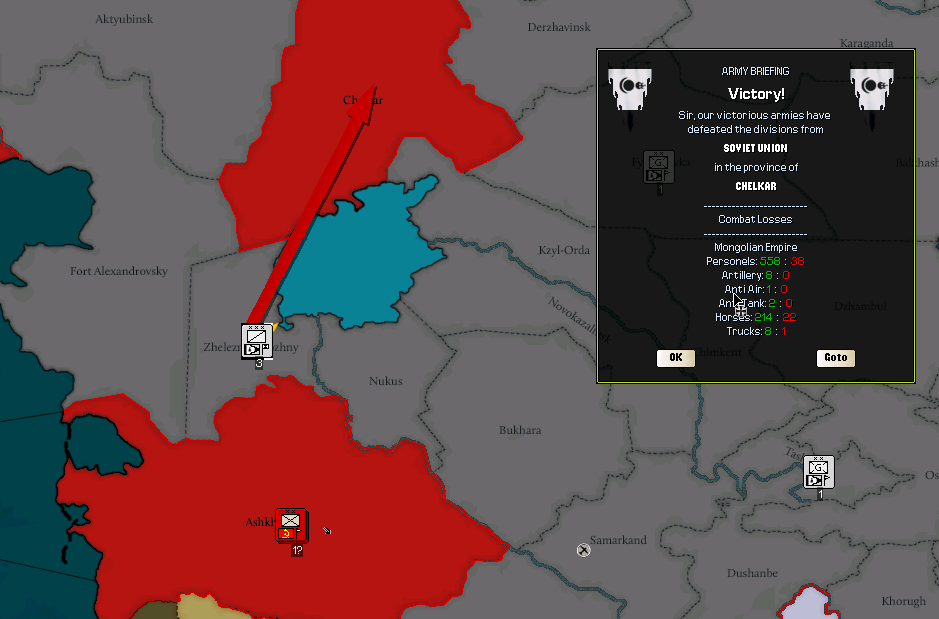 The northern half was destroyed. 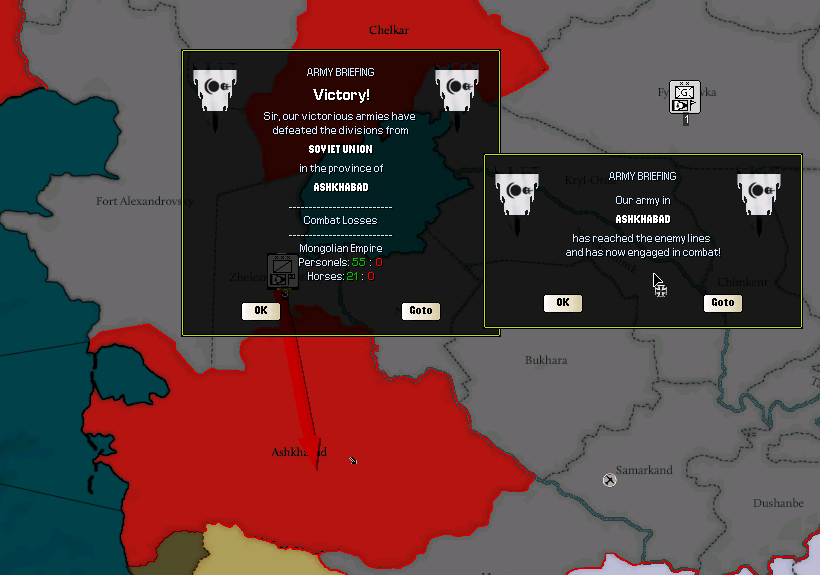 Followed by the southern half. Three down. 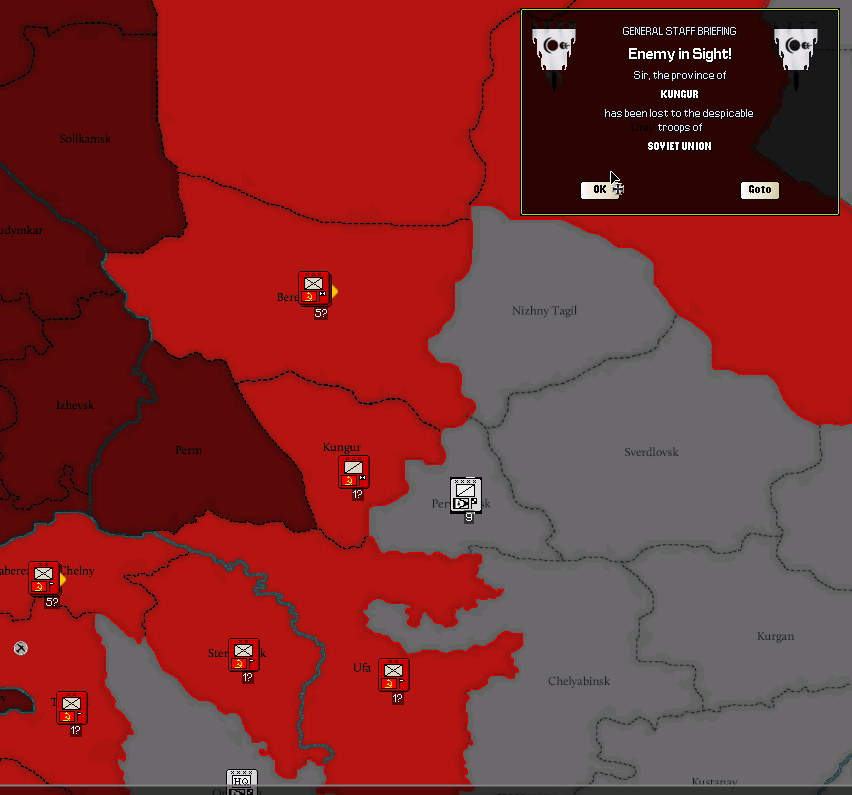 After the successful encirclement in Sterlitamak, the Mongols moved back. The war was beginning to gain the world's attention. Nobody had really taken the Mongols seriously at this point, since they had mainly conquered small and backward nations. While the Soviets were hardly up to the standard of Germany or France, they were considered to be at least a second tier power. Their troubles against a numerically inferior Mongol force was attracting the world's attention. Observers described the Mongol tactics as 'strike and fade'. The Soviets could not pin down the Mongols into a battle where they could use their numerical superiority. 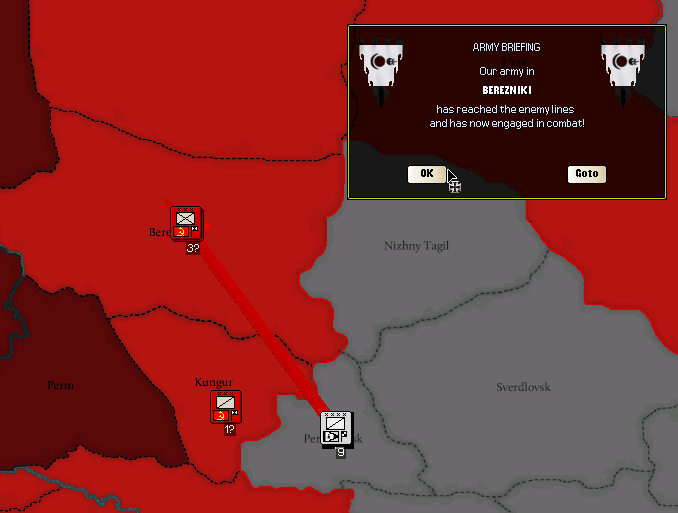 More Soviet units moved through the far north. While they could likely be trapped into Uray again, the Khan was insistent that some forward progress be made. The Soviet losses would only be of use if the Soviets could be prevented from replenishing them, and this necessitating seizing their population centers and industrial cities. 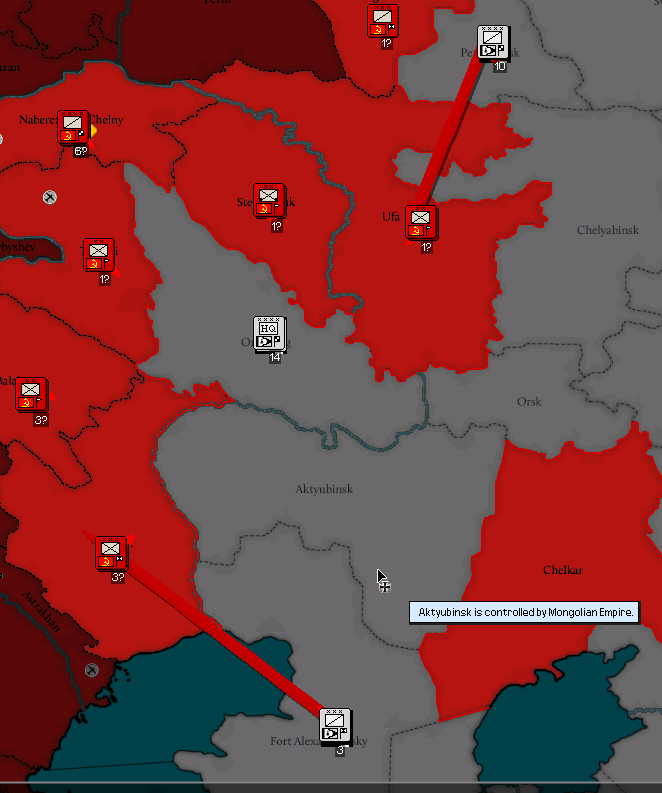 Fresh Mongol recruits had finished their horsemanship training and were deployed to the front. 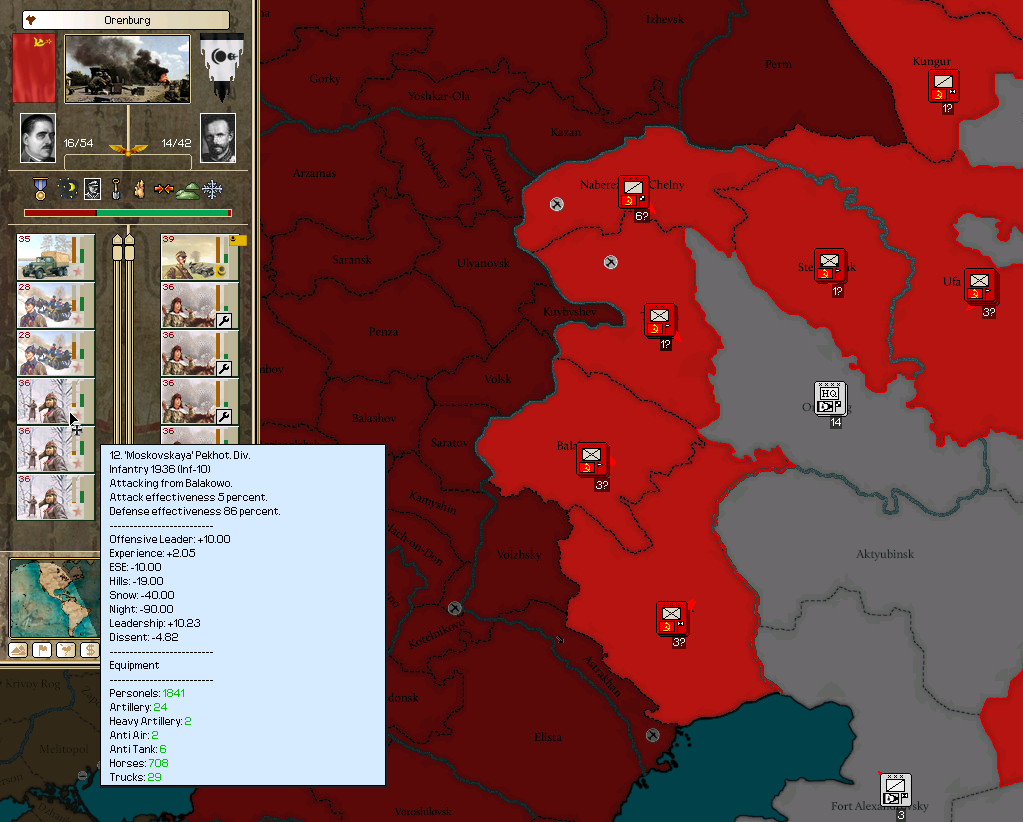 The Soviets began an assault from many directions on the Khan in Orenburg. Their divisions were grossly understrength, they were blinded by snow and the losses incurred were beginning to take a political toll, as the soldiers wondered if staying to fight was wise. 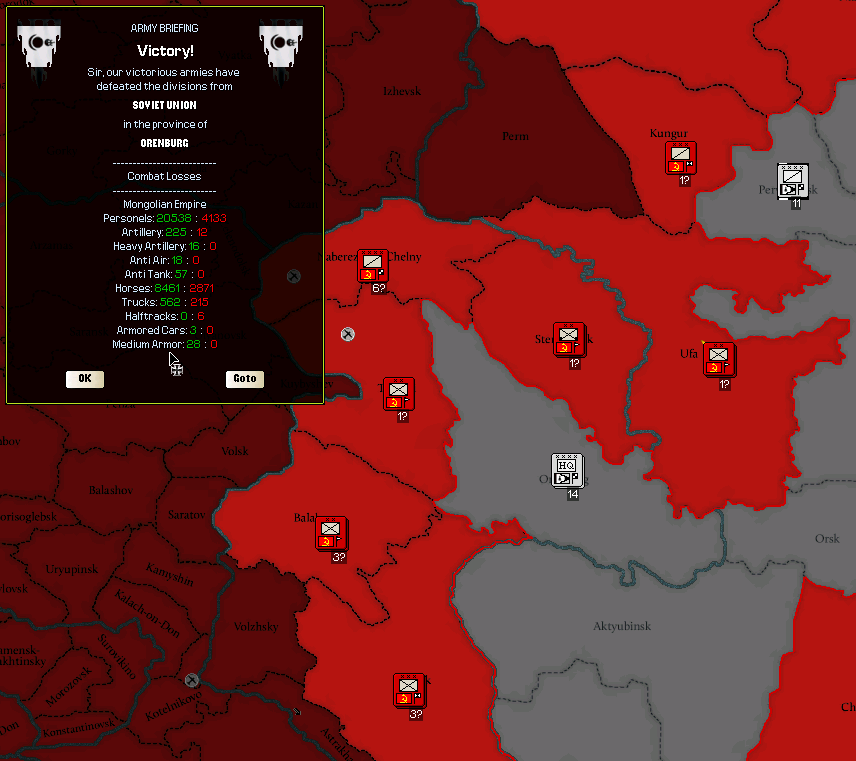 The attack predictably faltered, at great loss to the Soviets. 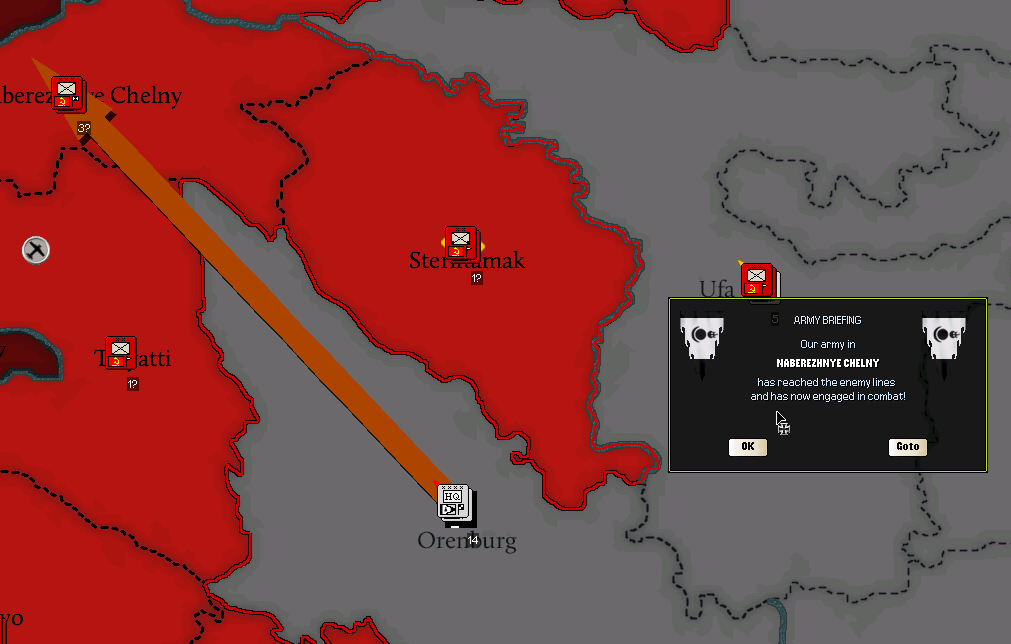 The opportunity for counterattack was ripe. Another potential pocket was forming in Sterlitamak with the recapture of Ufa. 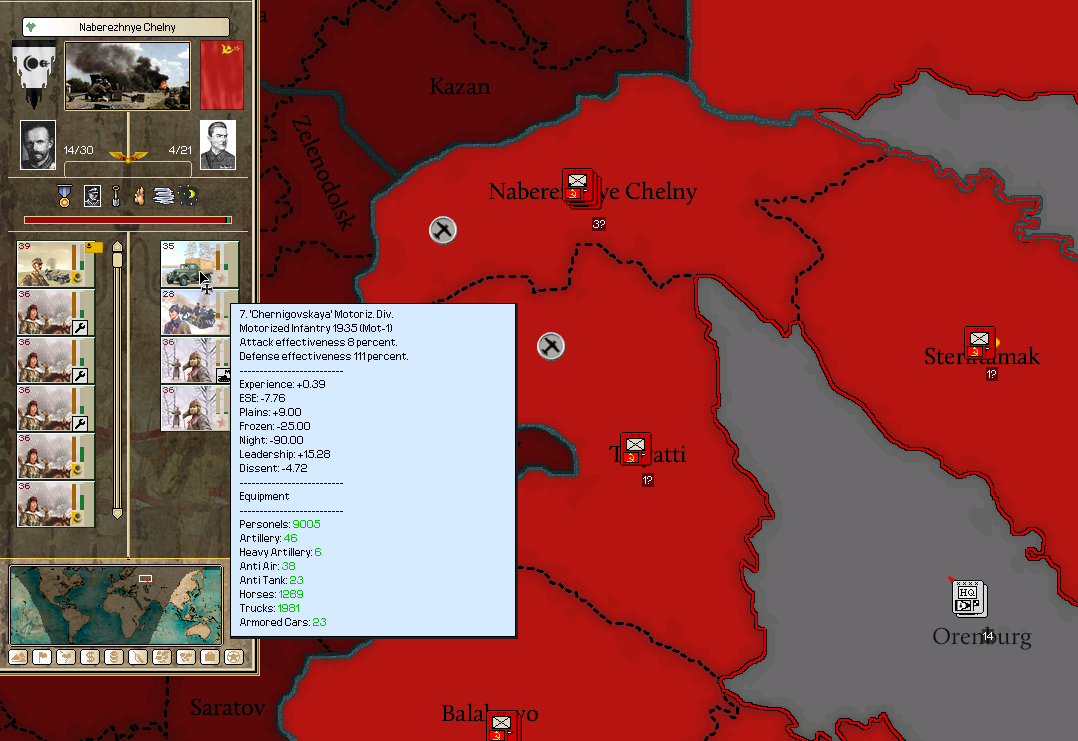 The Soviets had begun to deployed motorized infantry units. They were speedy, but they were deployed at the wrong time. The frozen terrain and poor infrastructure of the area did not lend themselves to wheeled vehicles. 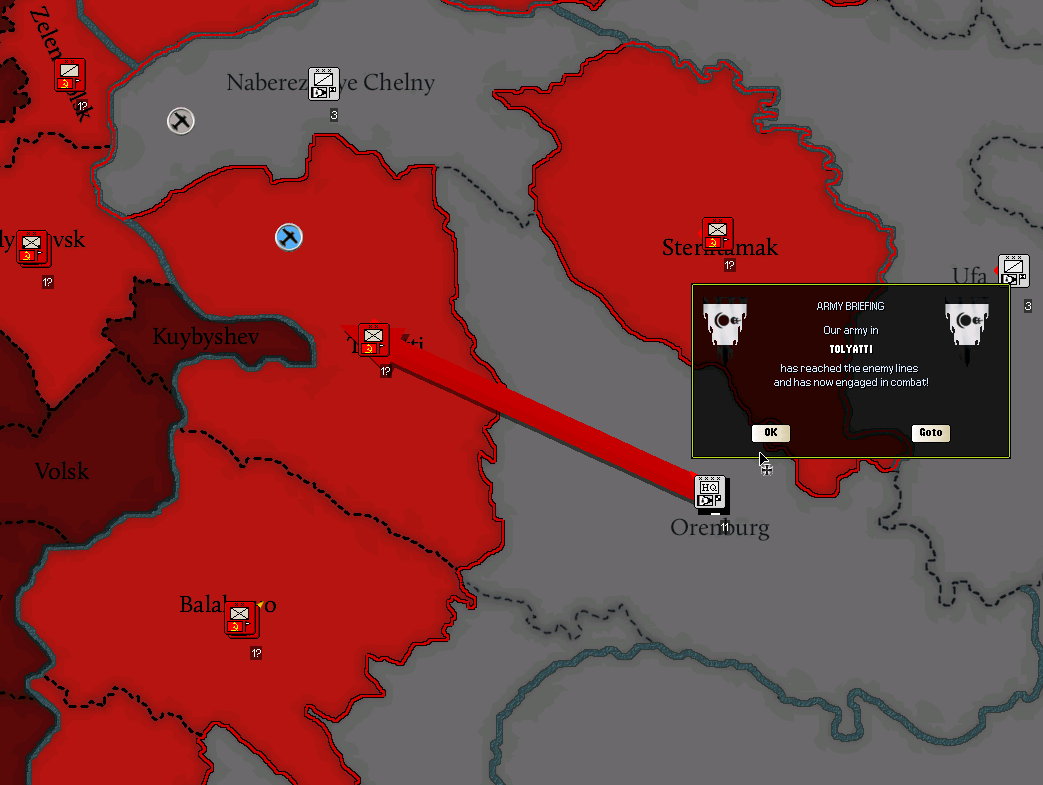 The newly recruited horde finished the advance while the Khan's horde stayed in Orenburg to recuperate. From here, they were able to strike west, having rested themselves. 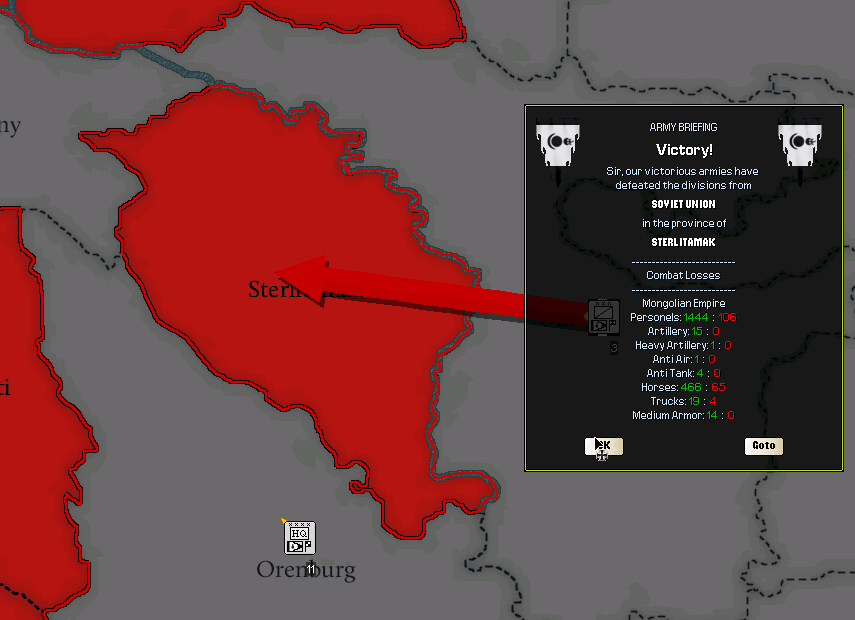 One division down. The Mongols had taken out eleven in total and blunted the Soviet attack. The Red Army was in disarray, the Volga within sight. Still, the gains made would only be meaningful if they ended in victory. And that meant destroying the Soviet Union once and for all.
|
|
|
|
Pretty ironic to let the USSR advance into your vast territory so they overextend themselves. Great encirclement strategy though, holy gently caress. I love cav-only armies.
|
|
|
|
Excellent work! What does your IC look like right now? Manpower situation okay?
|
|
|
|
GrossMurpel posted:Pretty ironic to let the USSR advance into your vast territory so they overextend themselves. Don't forget the Soviets being hurt by the winter!
|
|
|
|
Alikchi posted:Excellent work! What does your IC look like right now? Manpower situation okay? IC at the beginning of this war was at 48 base and 66 actual. TC was slightly overloaded (and by the time of this update significantly overloaded). The manpower situation is great, getting about 1.4 a day and sitting on about 153.
|
|
|
|
Part Six: February-October 1940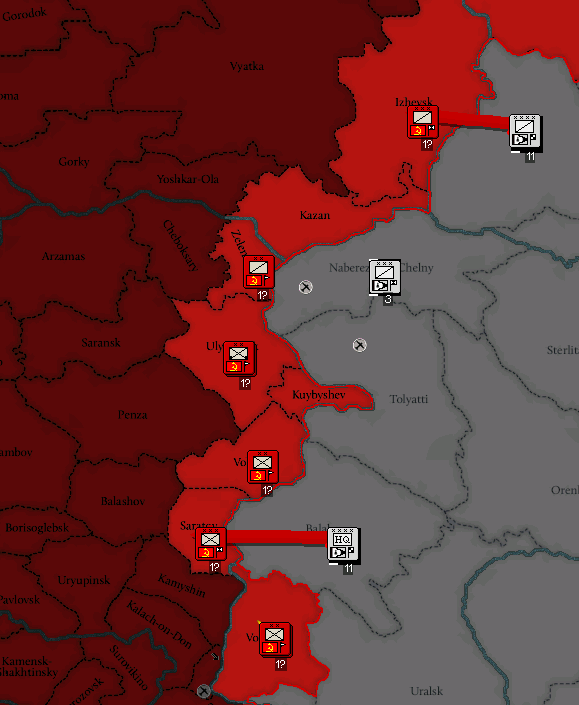 The Soviets were in poor shape, and could not muster many men to resist the Mongol assault across the Volga river. 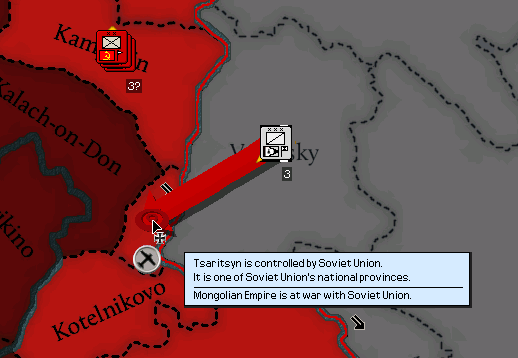 The smaller hordes went for targets such as Tsaritsyn. 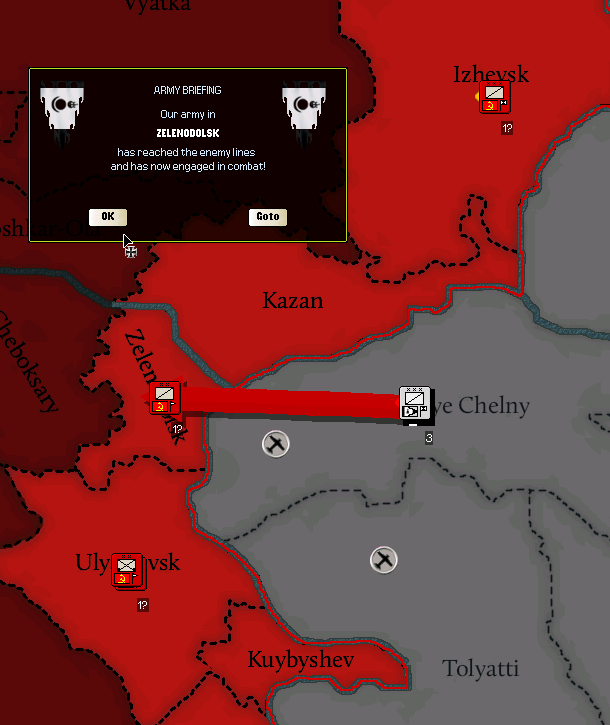 Another small horde moved across the Volga south of Kazan. 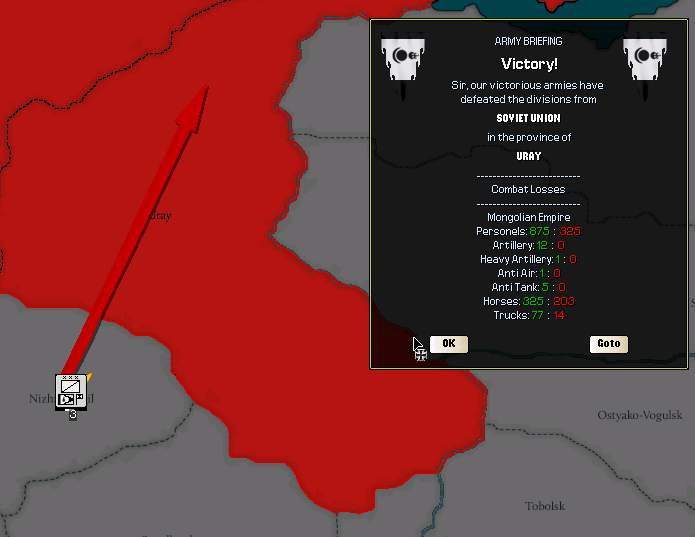 And yet another completed another Uray trap. 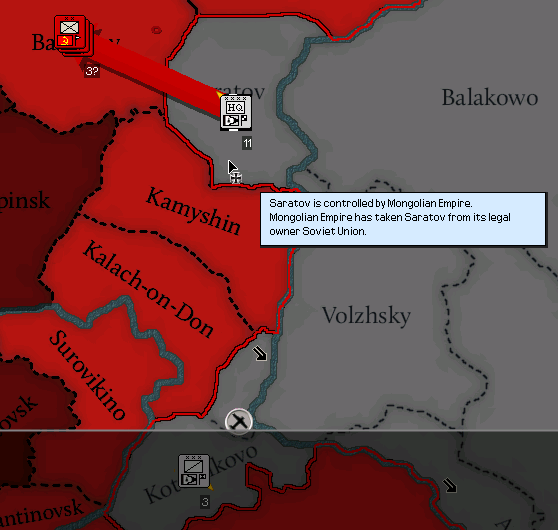 The Mongols made quick progress on the western bank of the Volga. 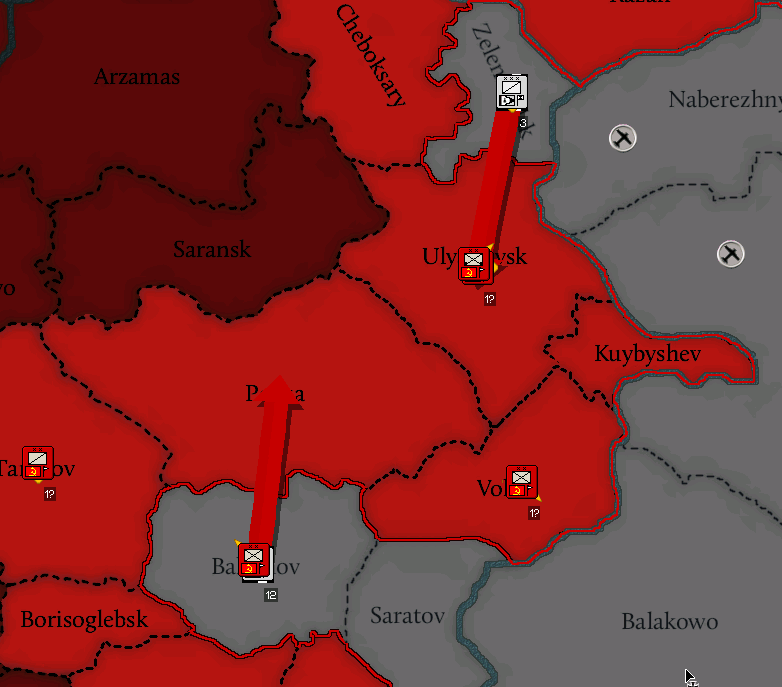 In the north, a potential pocket was forming around Kuybyshev. 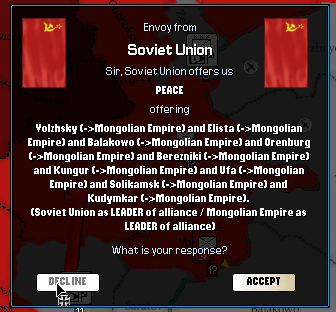 The surest sign that the war was going well was when the Soviets came hat in hand to the Khan with an offer to cede frontier areas to the Mongols in exchange for peace. The only thing they accomplished was getting their emissary executed and signaling that victory was inevitable. 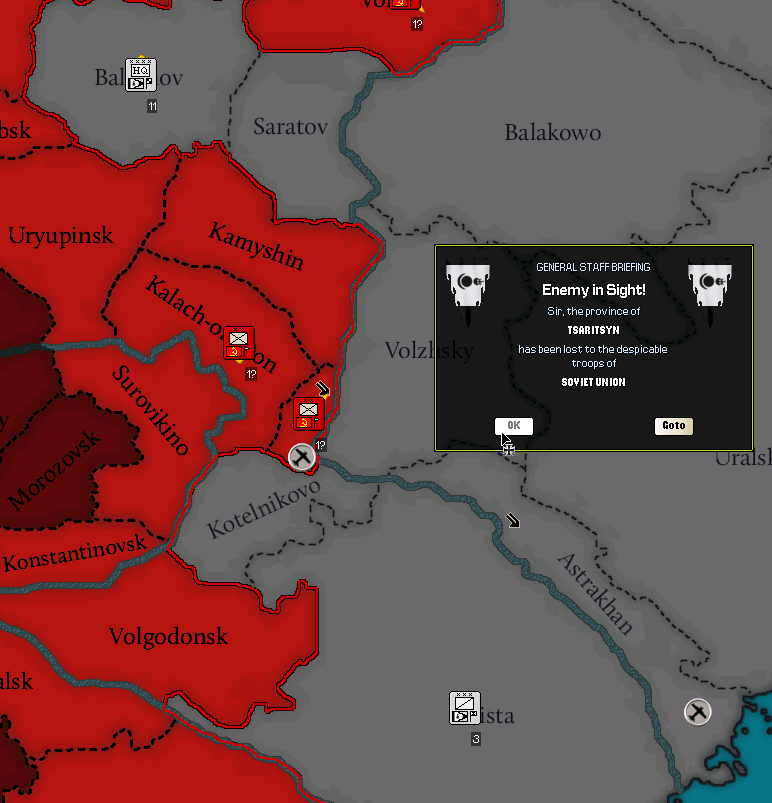 The Soviets recaptured Tsaritsyn. The Mongols had succeeded in razing the city's industry and so losing it again was not a terrible loss. It would fall permanently in due time. 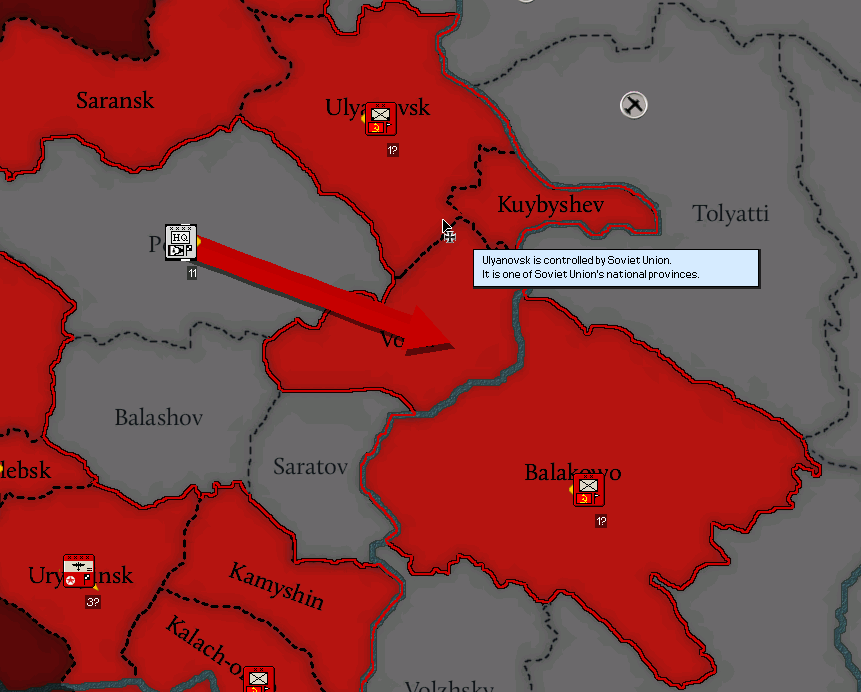 The rapid advance meant there was the risk of being cutting off. Establishing secondary escape routes was important. 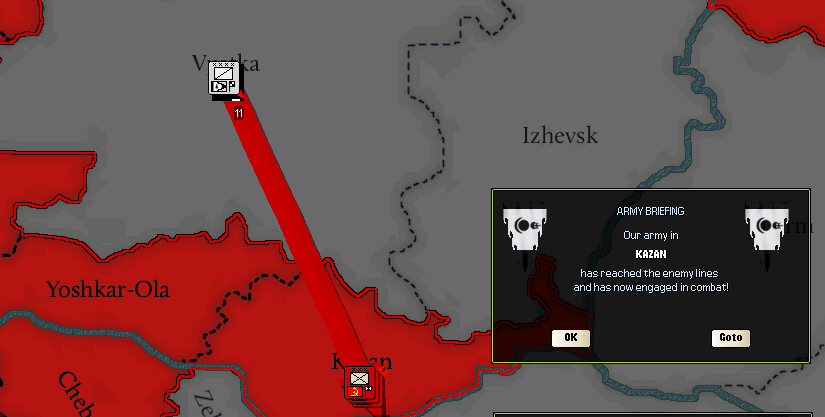 In the north, the horde wheeled south to prevent a Soviet army in Kazan from cutting them off. 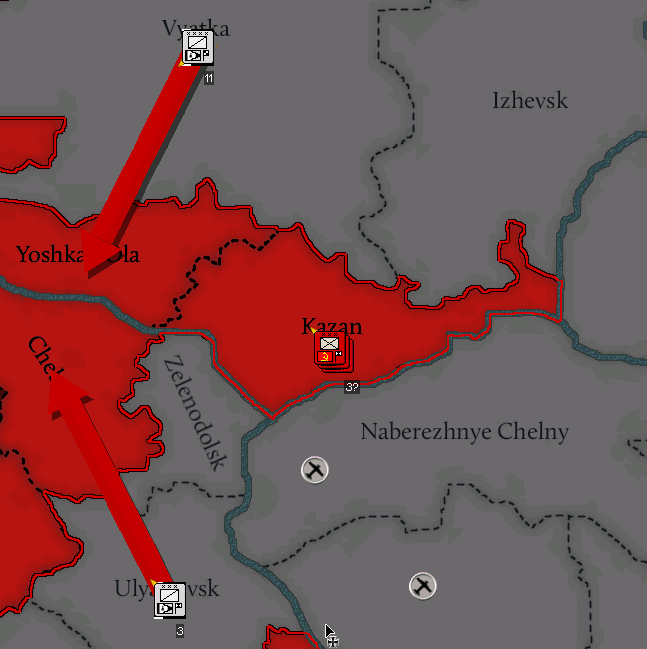 This presented an encirclement opportunity. 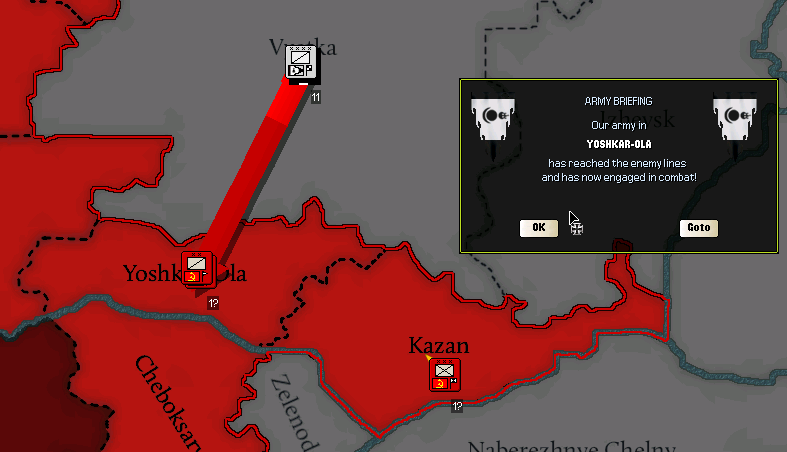 Unfortunately, some of the divisions would escape. 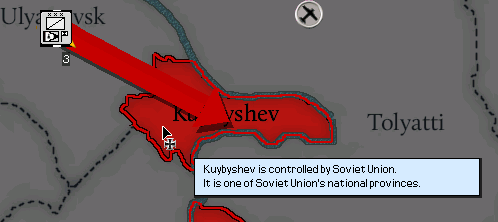 The Kuybyshev pocket was destroyed, however, claiming another Soviet division. 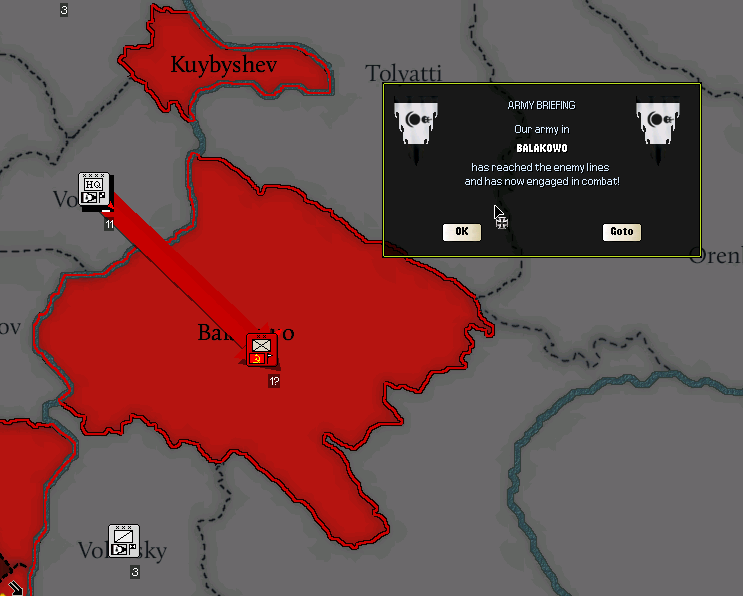 This was followed shortly by the news that the Balakowo pocket was destroyed. 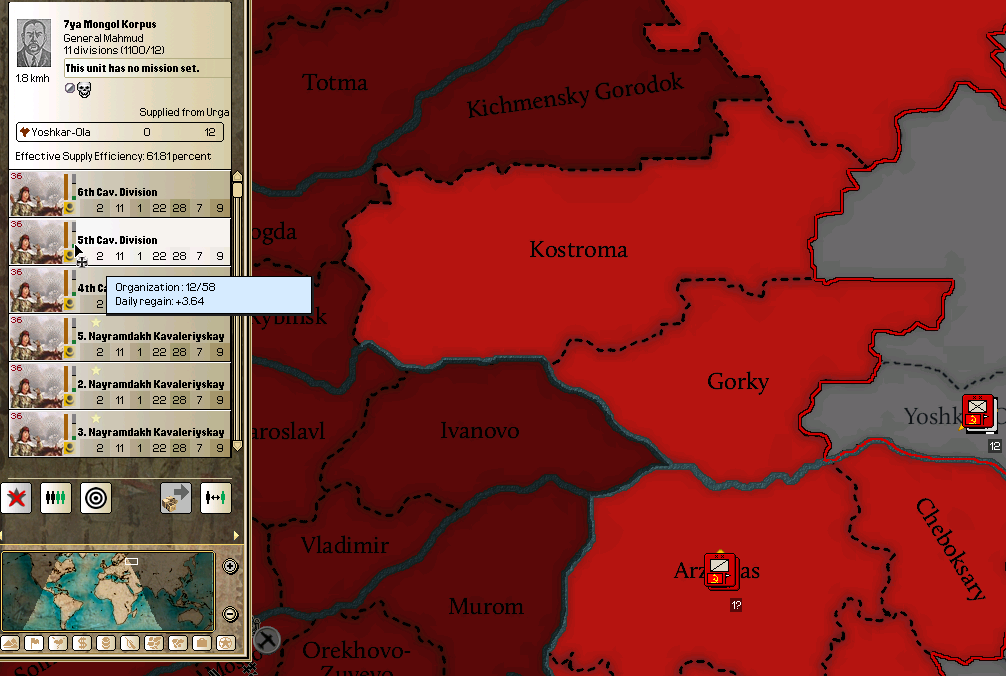 The many rapid manuevers and battles had taken their toll and some of the armies had to rest up for the killing blow to the Soviet Union. 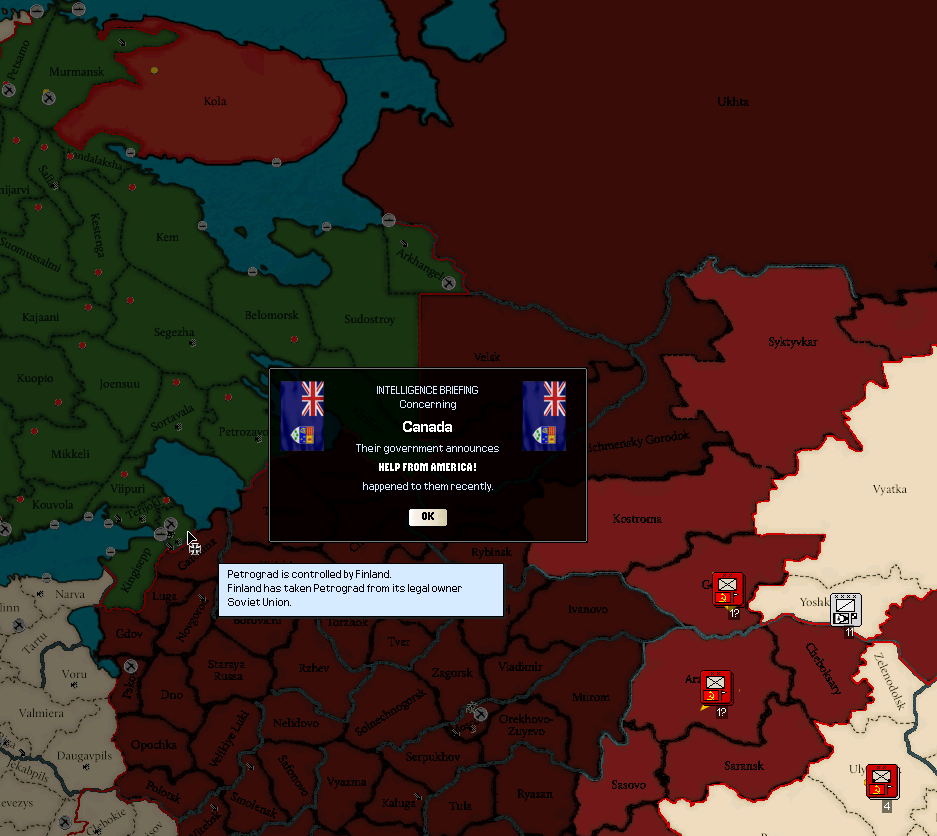 The Soviet Union's impending demise did not go unnoticed. Finland, who was growing increasingly worried about being isolated in a Europe dominated by the International, took the opportunity to eliminate its historical Russian nemesis and moved across the lightly defended border, having already seized Petrograd and Arkhangelsk.  This provided an impetus to finish the war. Moscow would be Mongol and not Finn, the Khan was insistent on that. 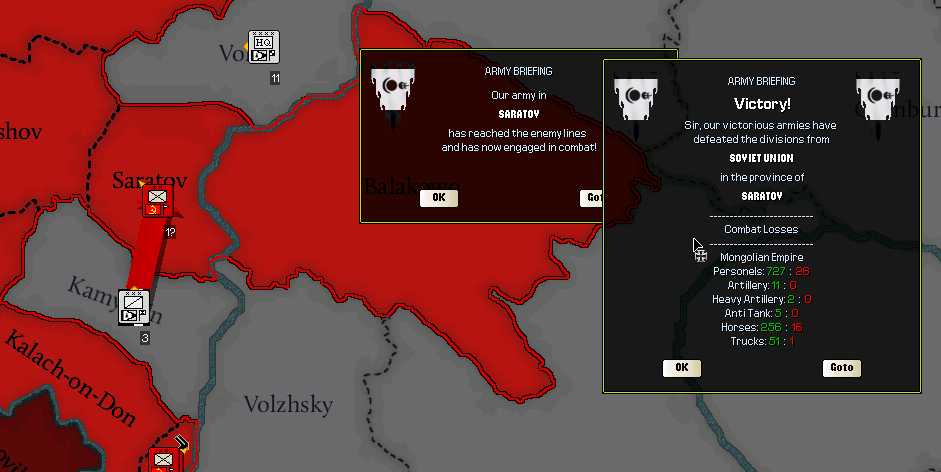 The main hordes advanced while the smaller hordes tried their best to screen their advances, beating off errant Soviet divisions attempting to cut them off. 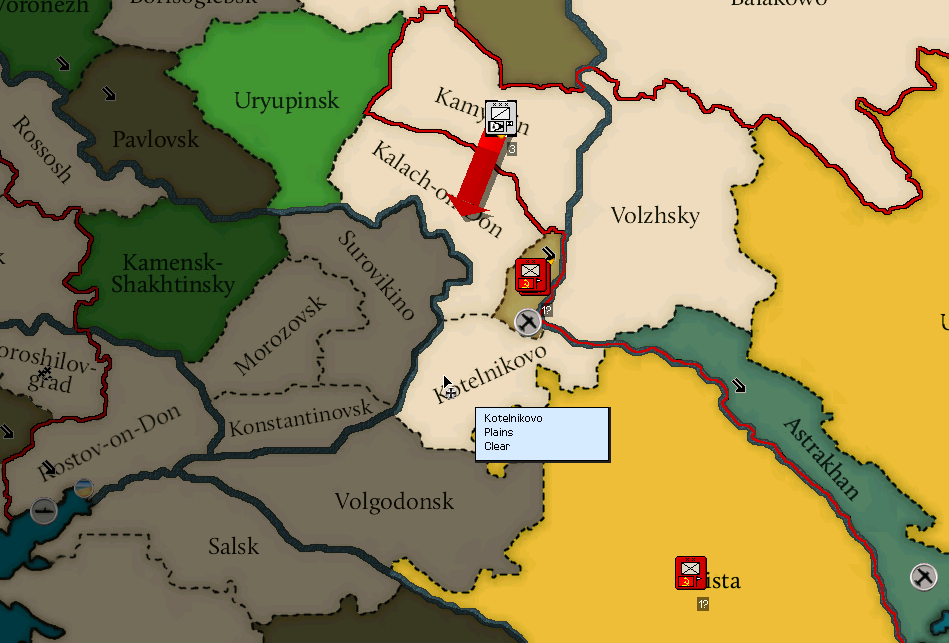 The terrain was also more hospitable for the cavalry in this area. 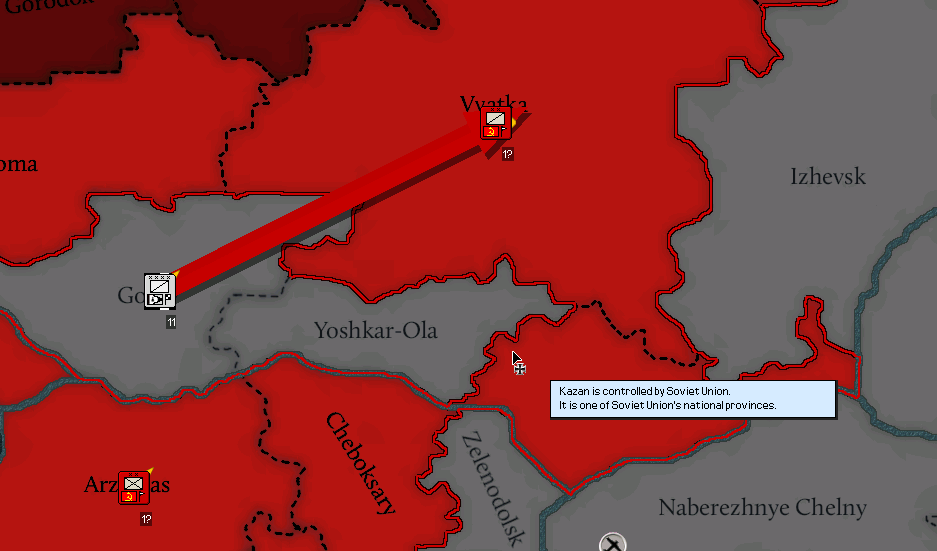 The Mongol tactic of deep penetration brought inevitable complications. 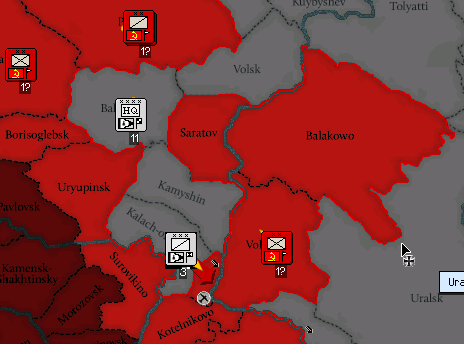 The situation sometimes seemed tenuous but the superiority of Mongol forces meant that any successful encirclement could easily be broken if the Mongols counterattacked before they ran out of supplies. 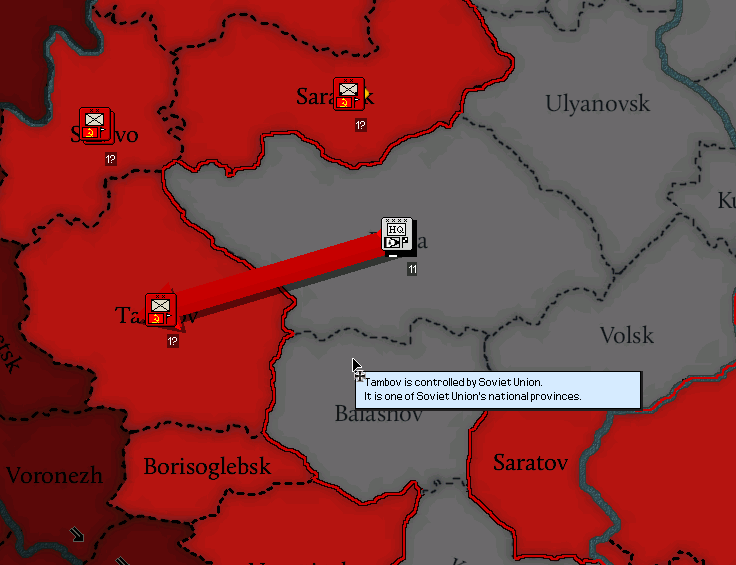 Moscow beckoned.  Nothing would turn the Khan around. 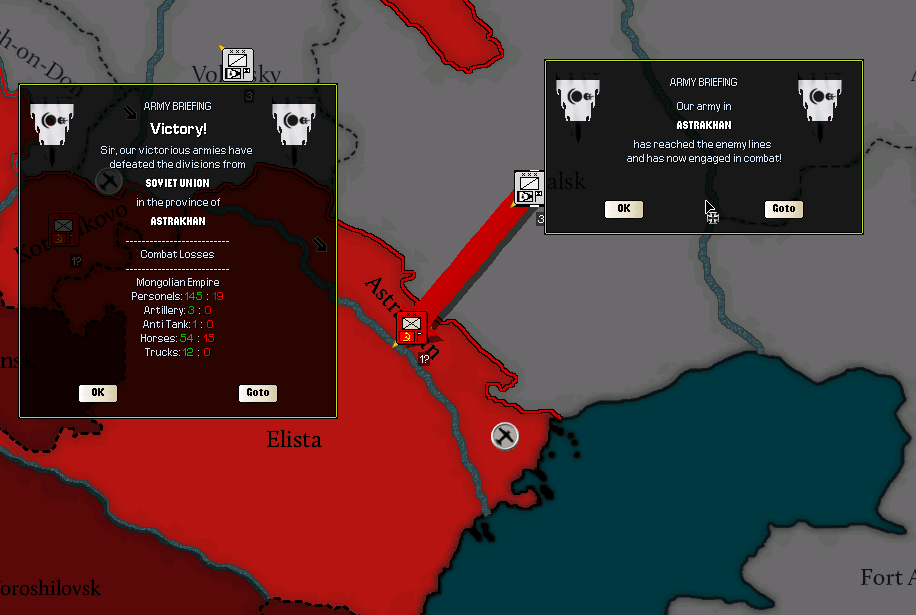 Astrakhan had been abandoned and it was finally time for the Mongols to recapture it. It also was the route to the Caucasus. 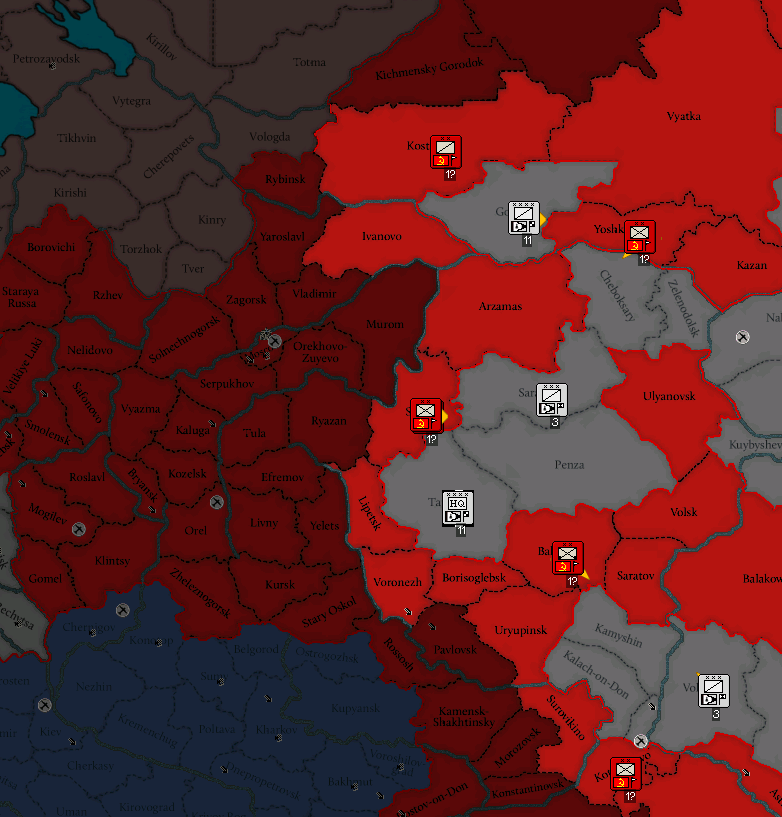 The Finnish advance was lightning fast, likely due to the fact that the Soviets could not hope to cover such a wide front when they were already being overwhelmed across the Volga. 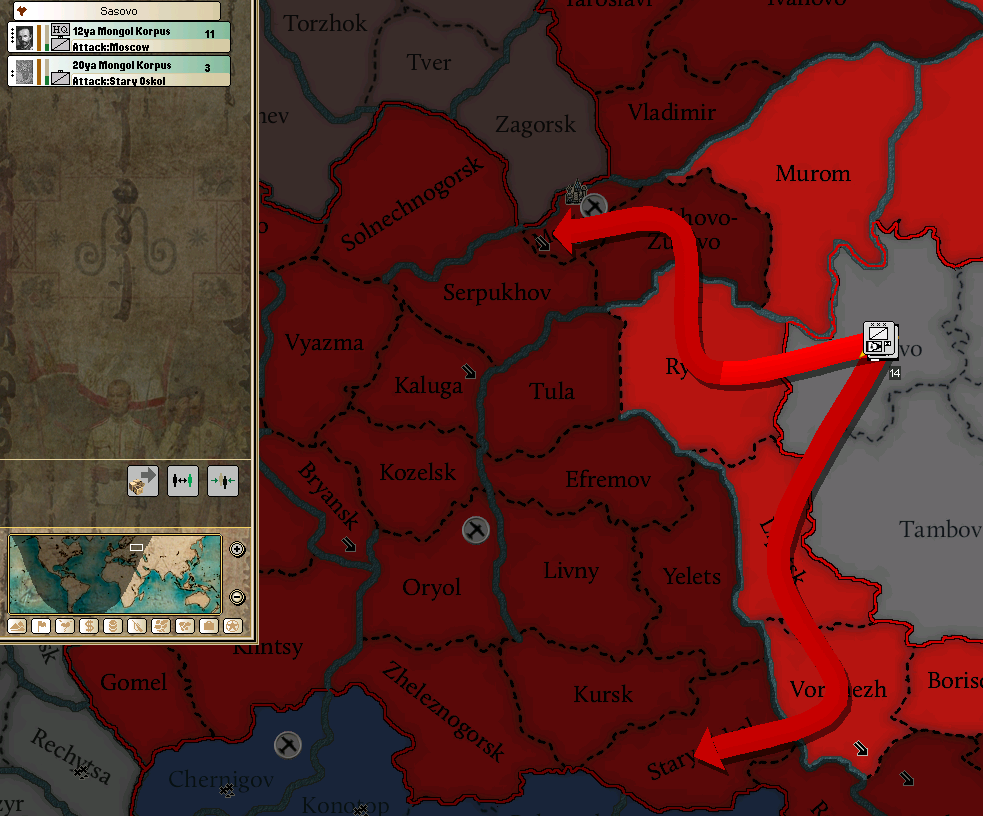 The Finns had already captured the northern approach to Moscow. The Khan would make it there first, no matter the cost. 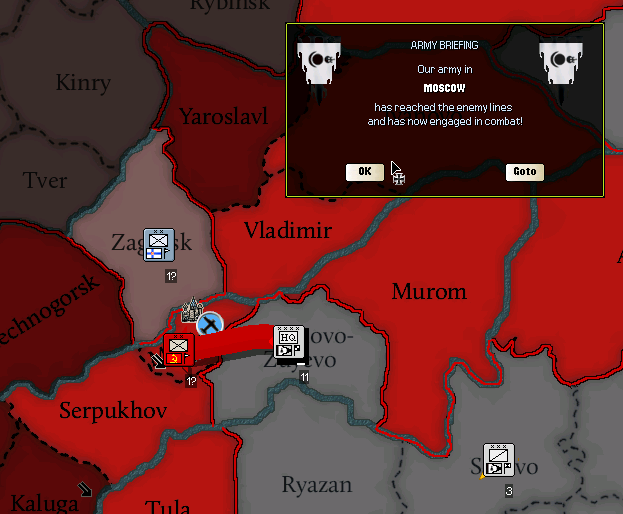 The Finnish army had been resting on the other side of the river, waiting to attack Moscow. They were not as interested in the city as the Khan was. They had already claimed the prize of Petrograd.  The Soviets were evicted from Moscow in a battle that was more like a massacre. 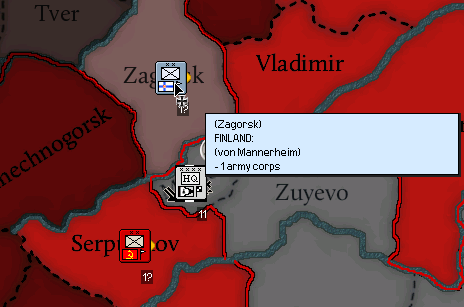 The Khan rode victoriously into Moscow. The Soviets had hoped to defeat the Mongols and forge a colossal empire across Asia. Instead their revolution was being put down, yet again. The Khan met with the skilled Finnish general Carl von Mannerheim in Moscow. They regarded each other with some suspicion but also a great deal of respect. Both had gotten what they wanted out of this war. 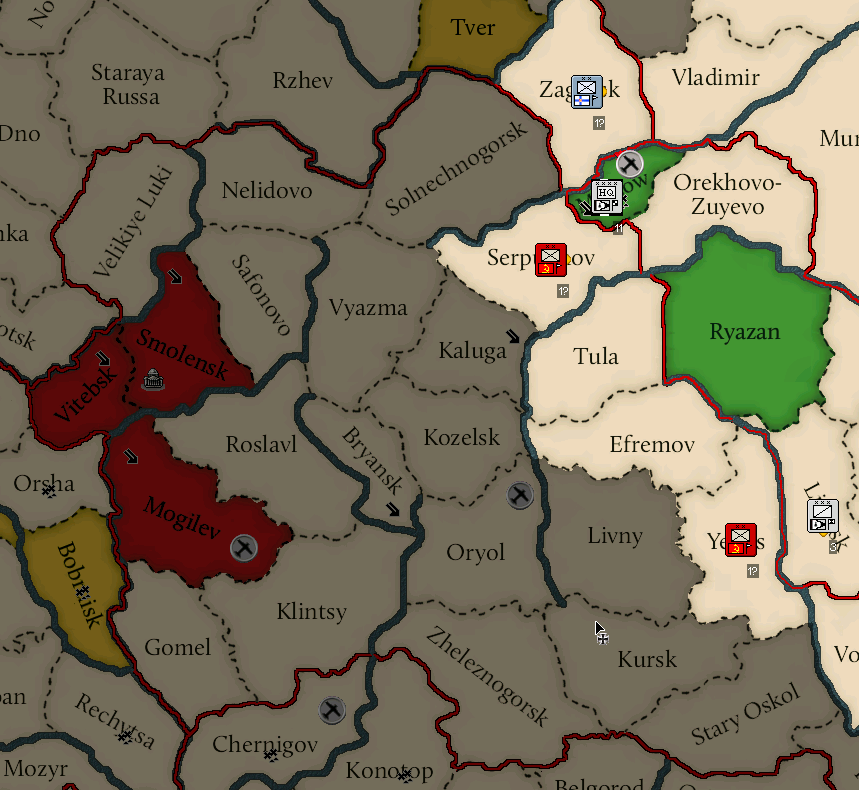 The Soviets had moved their capital to Smolensk, close to the International, with whom they were pleading for assistance. The French were not interested, apparently Totalism did not enjoy high esteem on the continent. 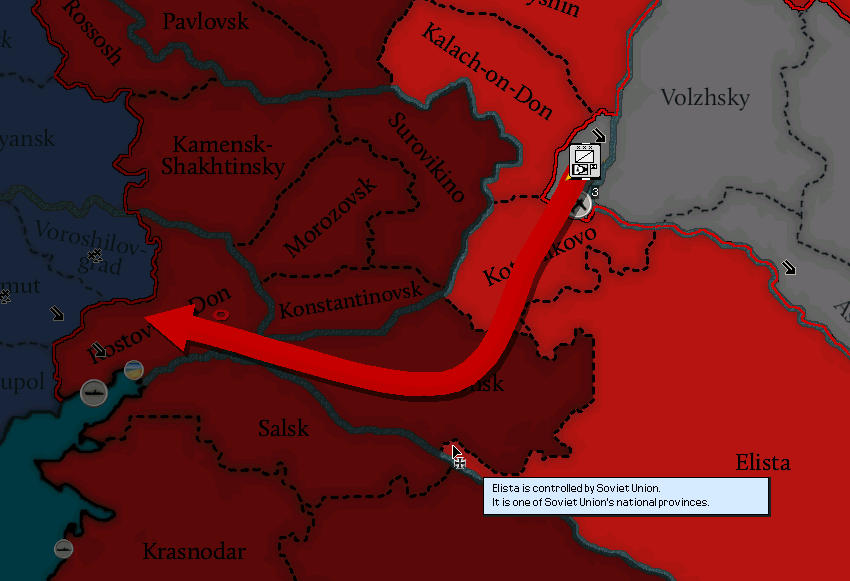 The Black Sea was another important objective. A European port was of some significance. 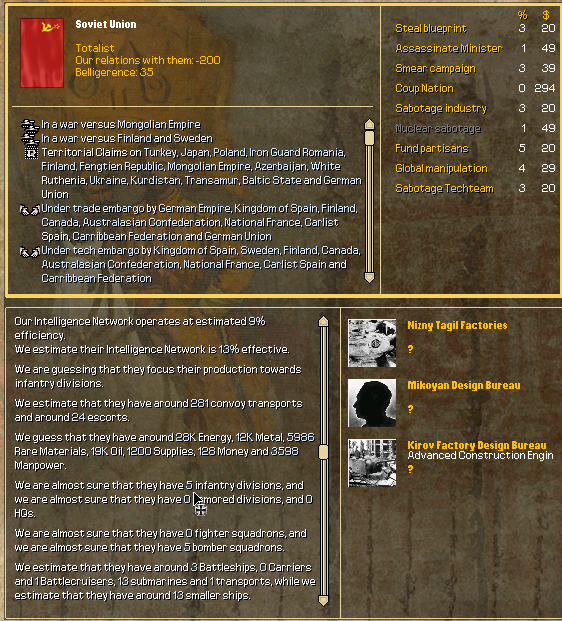 The war had been unbelievably bloody for the Soviets. Only five divisions remained at this stage in the war, out of forty seven that initially intended to invade Siberia. 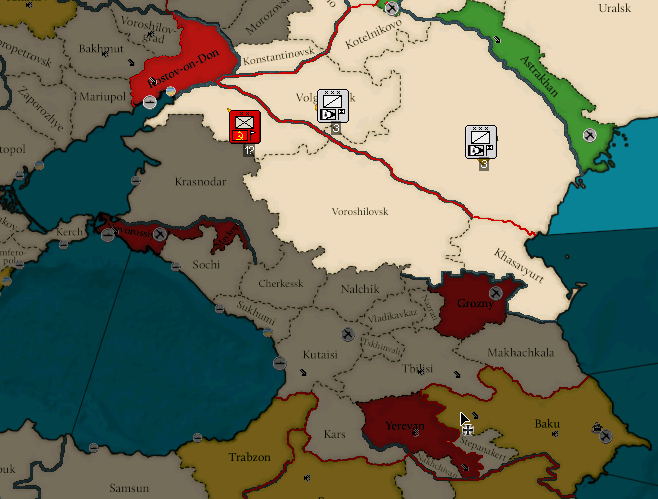 At this point, the war was more of a clean-up operation. 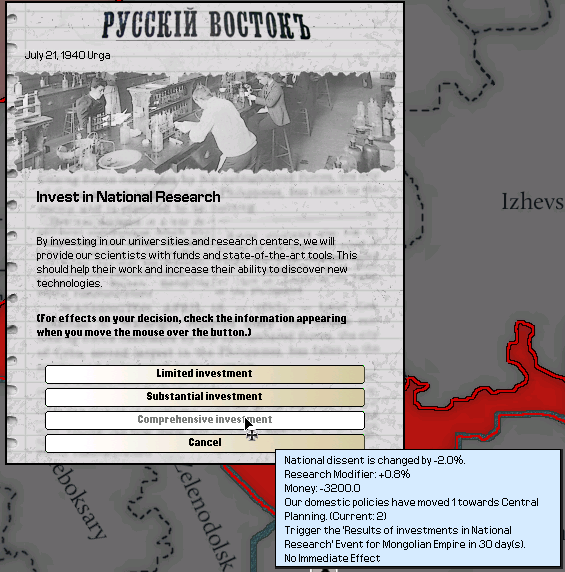 The Mongolian Empire was fighting increasingly modern forces. The Soviets were not considered a modern army and even they had some technology that the Mongols did not. Mongolia did not have many scientists and the scientists in the areas conquered had mostly fled or been slaughtered. The Khan decided to funnel large amounts of cash into research in the hopes of attracting foreign scientists to assist the Mongols. 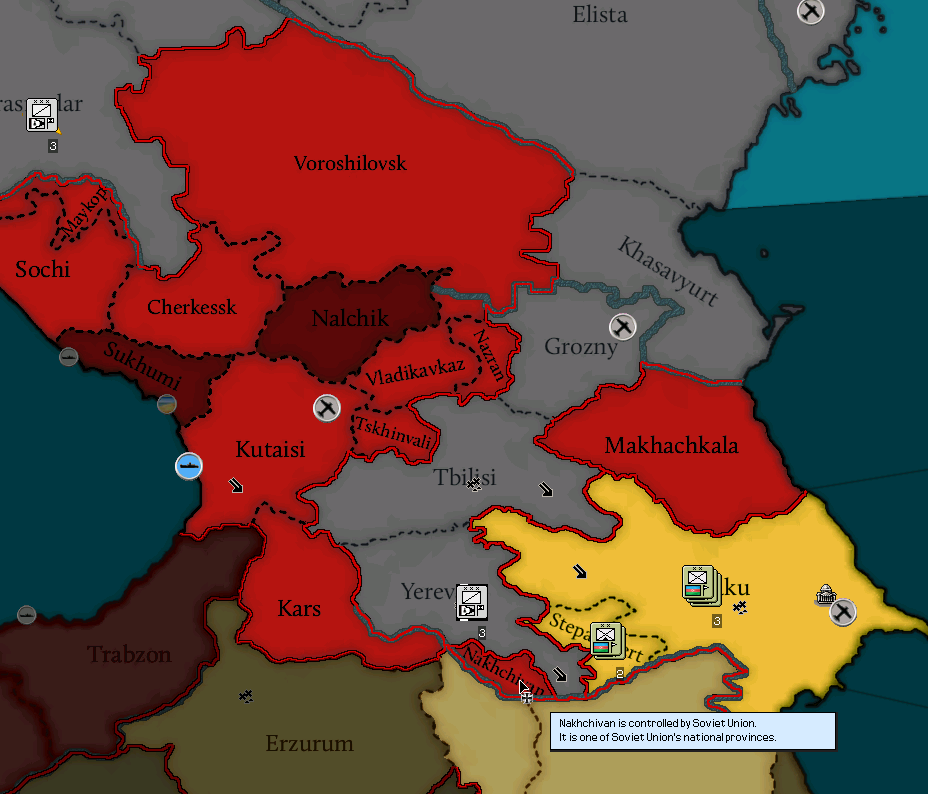 The Mongols marched from Astrakhan to Armenia without encountering any resistance. 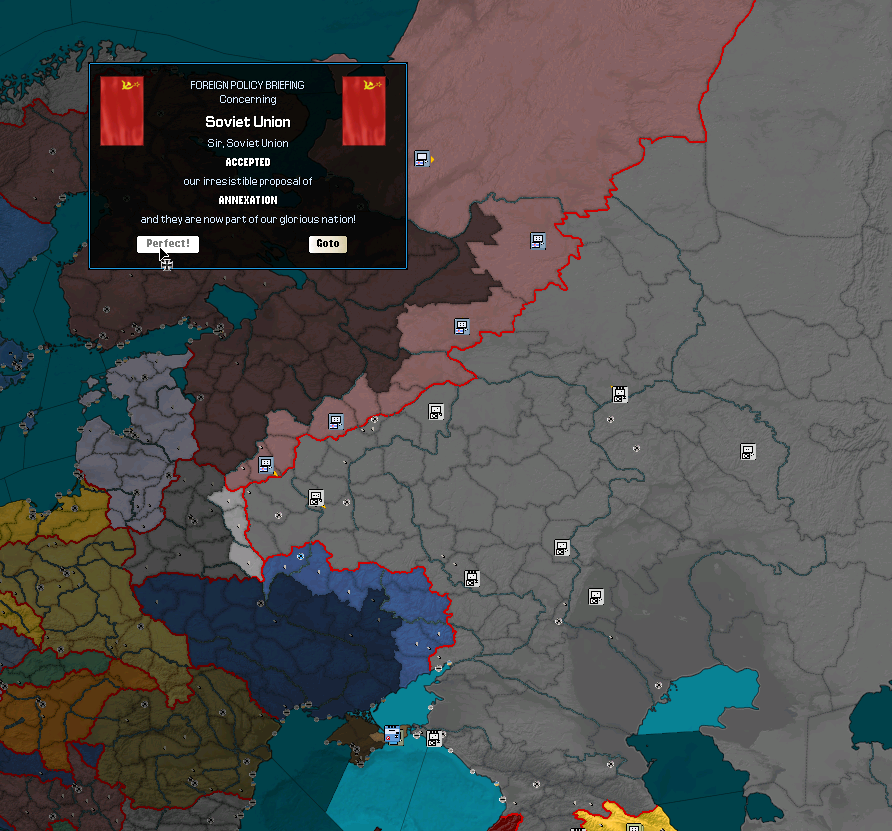 It was over. The Russian Revolution was dead. Russia, after centuries of independence, was no more, divided in two by two of its former subjects. 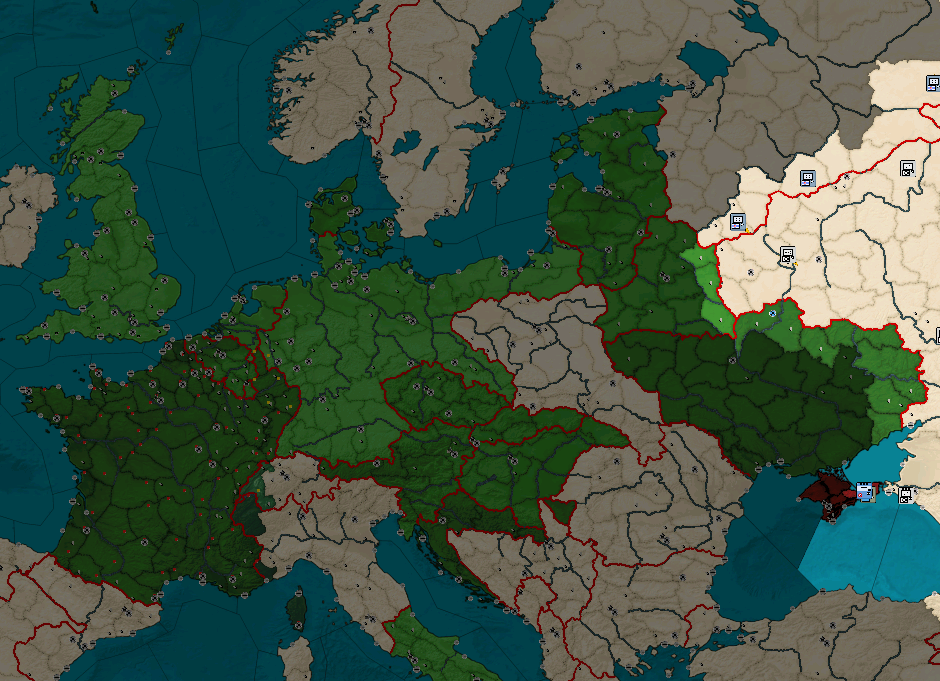 To the west loomed the mighty Syndicalist International. The alliance had achieved a rapid and total victory, with Mitteleuropa only hanging onto a Crimean stronghold. Paris was now the center of the world, and they certainly would not look kindly upon the Khan. They also were reportedly more concerned about building syndicalism than continuing to expand the International. For now, there would be peace. 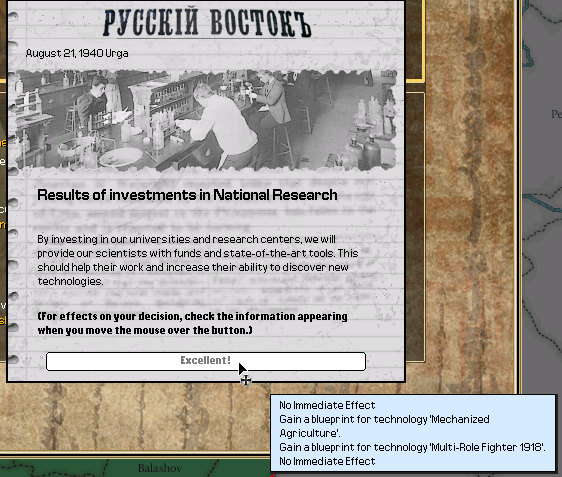 Either way, the Khan read a report from one of his hired scientists about airplanes. The Mongols had not had any need for them so far but perhaps they would soon enough. 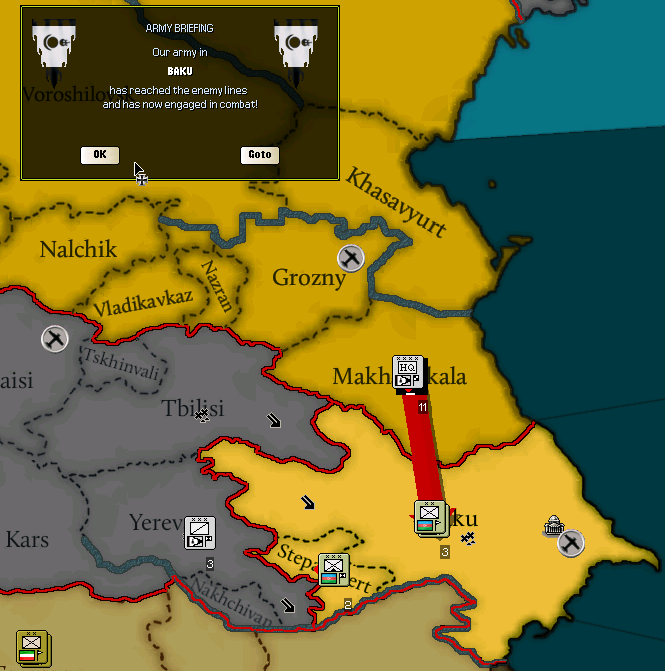 The oil fields of Baku would be helpful should they head in that direction. 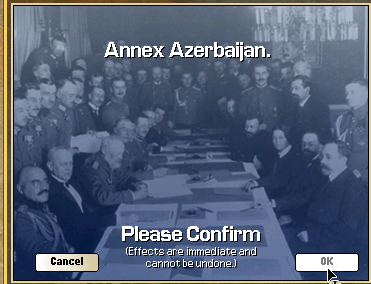 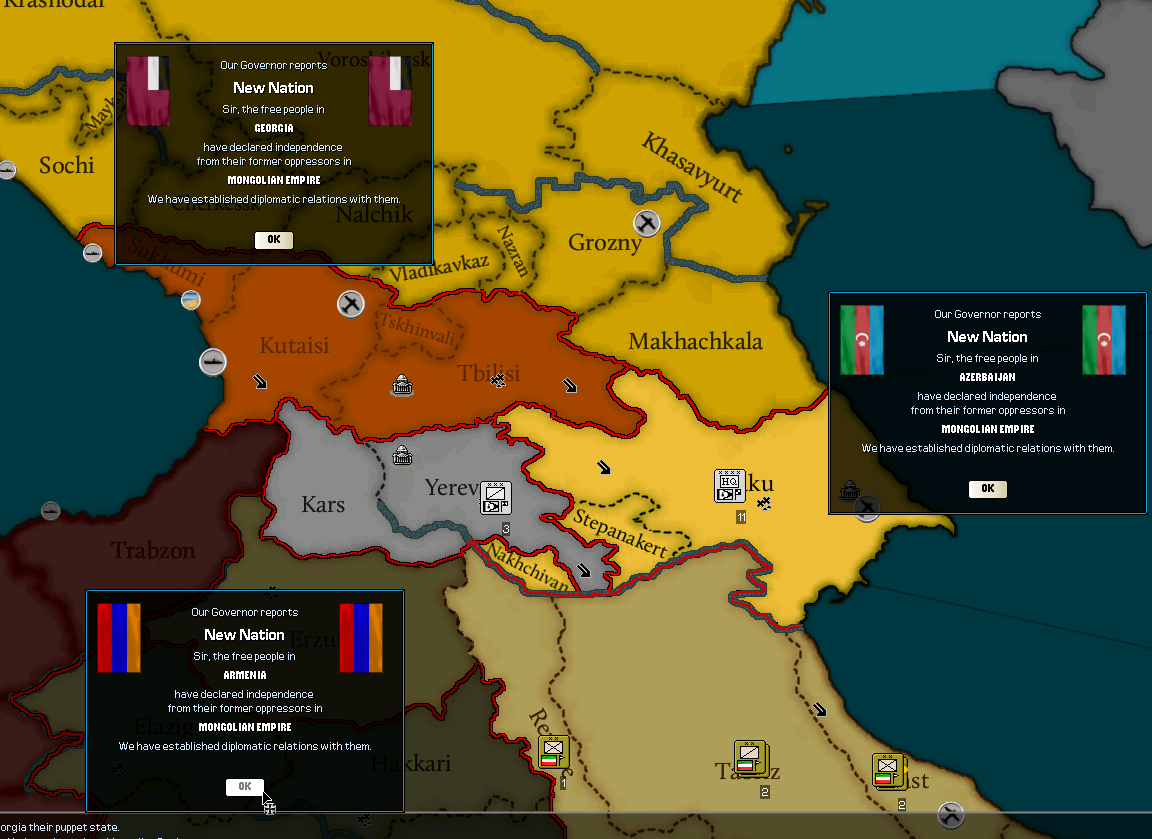 The Mongol Empire had expanded an unbelievable amount in the last four years. From its ignored home in Mongolia, the Khan had gone all the way to the Black Sea and established tributary states, like the Khans of old. 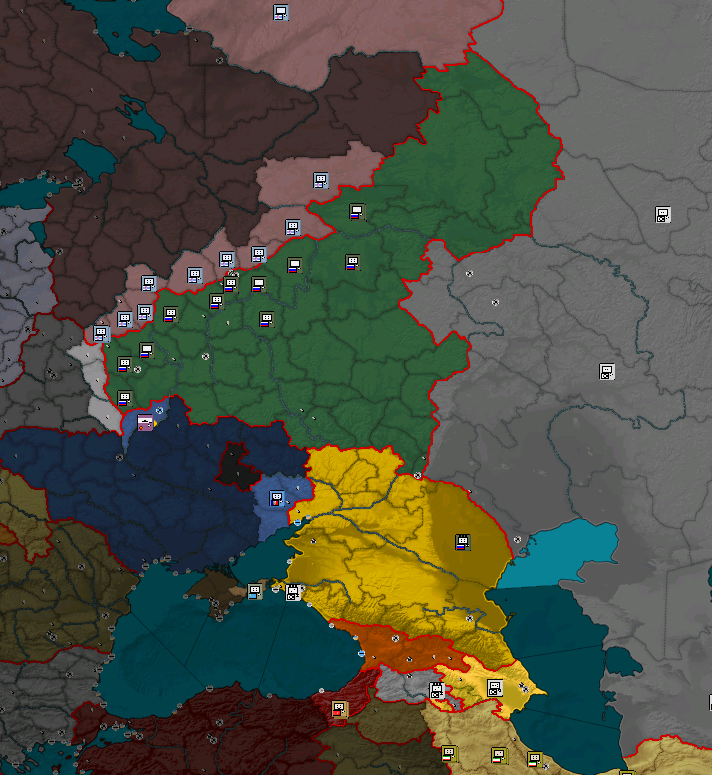 The Mongol empire would keep control of everything up to the Volga (I did eventually trade them those three provinces around Kuybyshev to make the border smoother). The Cossacks were given their own puppet state and the remainder of Mongolian Russia was set up as a rump Grand Duchy under Wrangel. They would prove to be a useful ally in the battles to come.
|
|
|
|
Never get involved in a land war in Asia. -Vizzini of Sicily https://www.youtube.com/watch?v=m5nlD2CR7tI -John Green
|
|
|
|
I was in a similar situation once as the Qing. Fighting with 200 cavalry divisions against 500 Syndicalist divisions was fun as gently caress, especially when I got to 1951 and started having helicopters.
|
|
|
|
cokerpilot posted:Never get involved in a land war in Asia unless you have the Mongols on your side
|
|
|
|
If anybody is reading this and doesn't have Darkest Hour then post your steam profile link in here and I will send you a copy. I've got three.
|
|
|
|
I'd love to get DH just to try Kaiserreich myself. My profile is e: thank you! Kellsterik fucked around with this message at 08:10 on Dec 28, 2014 |
|
|
|
Chief Savage Man posted:If anybody is reading this and doesn't have Darkest Hour then post your steam profile link in here and I will send you a copy. I've got three. Sure thing, chief.
|
|
|
|
Chief Savage Man posted:If anybody is reading this and doesn't have Darkest Hour then post your steam profile link in here and I will send you a copy. I've got three. okay Kulkasha fucked around with this message at 15:57 on Dec 27, 2014 |
|
|
|
Part Seven: October 1940-November 1941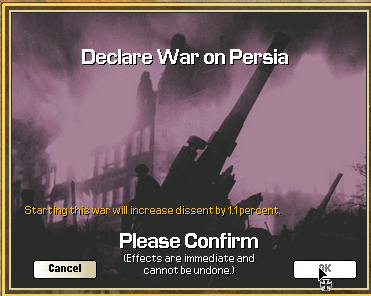 The capture of the Caucasus meant that there were two borders with Persia. 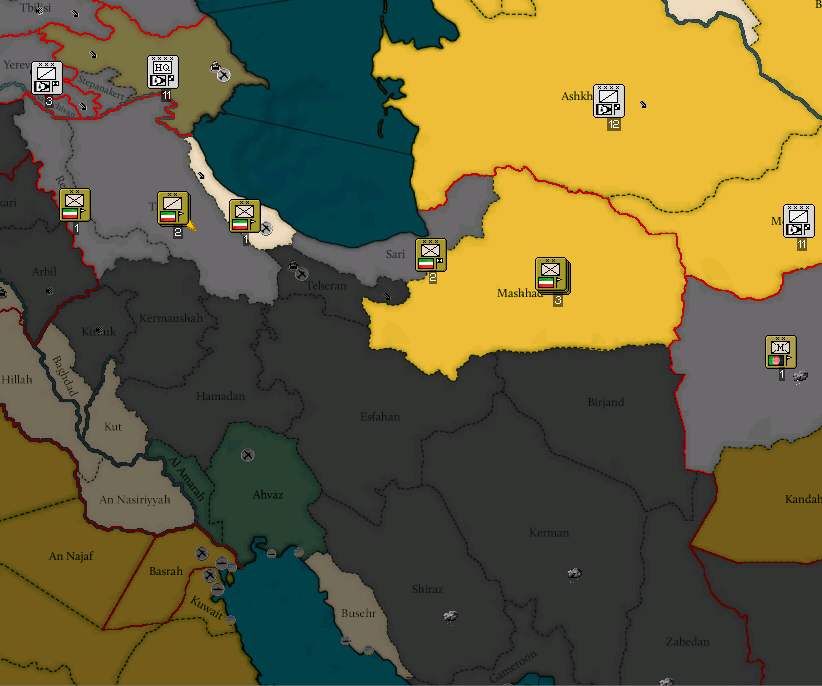 The rough terrain of Persia provided many defensive opportunities for the Persians and forcing them to spread out their forces would be helpful. 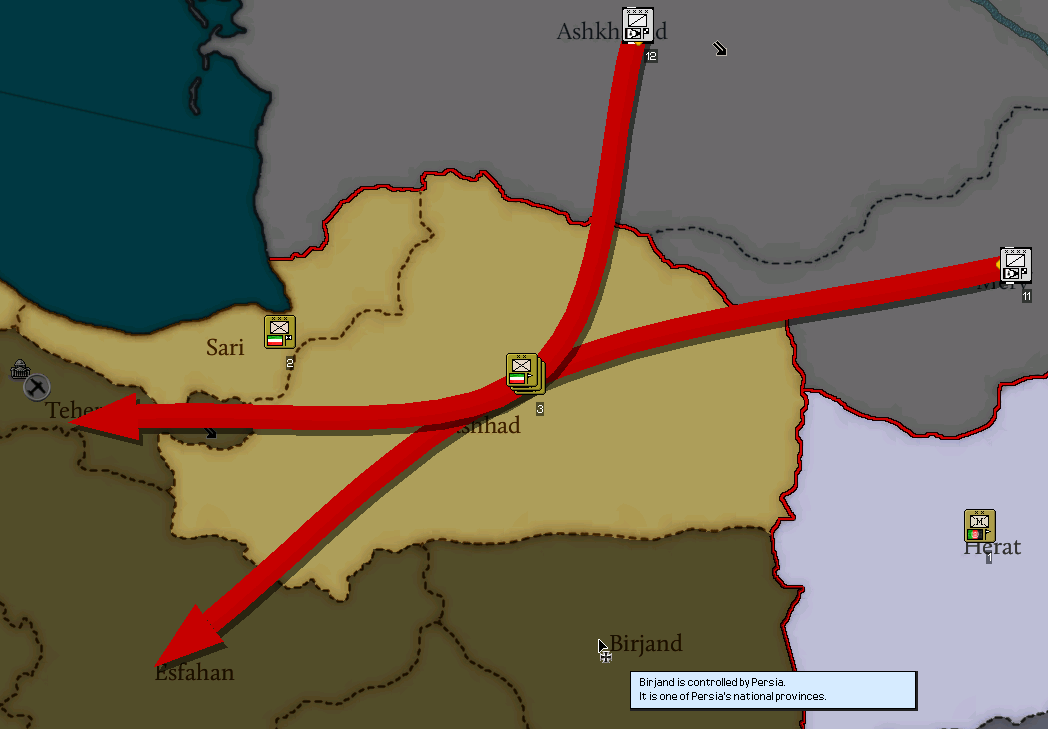 Two hordes struck from Central Asia through the desert towards the interior of the country, including the capital Tehran. 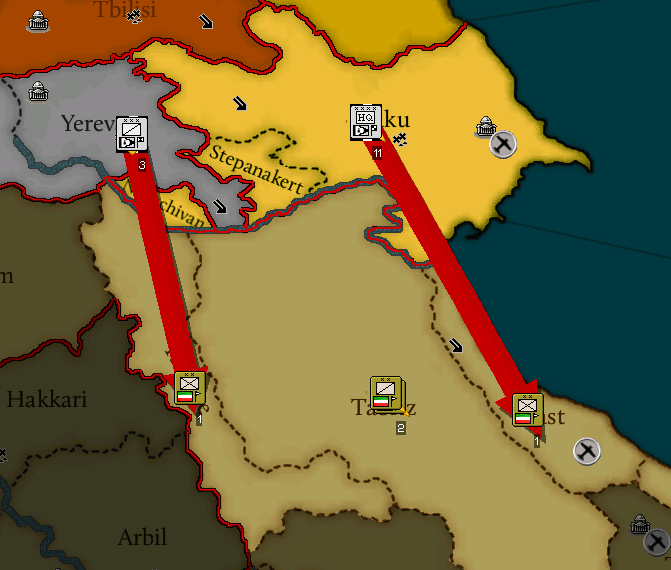 Thirteen cavalry divisions struck from the Caucasus, ten towards Tehran and three to Iranian Kurdistan. 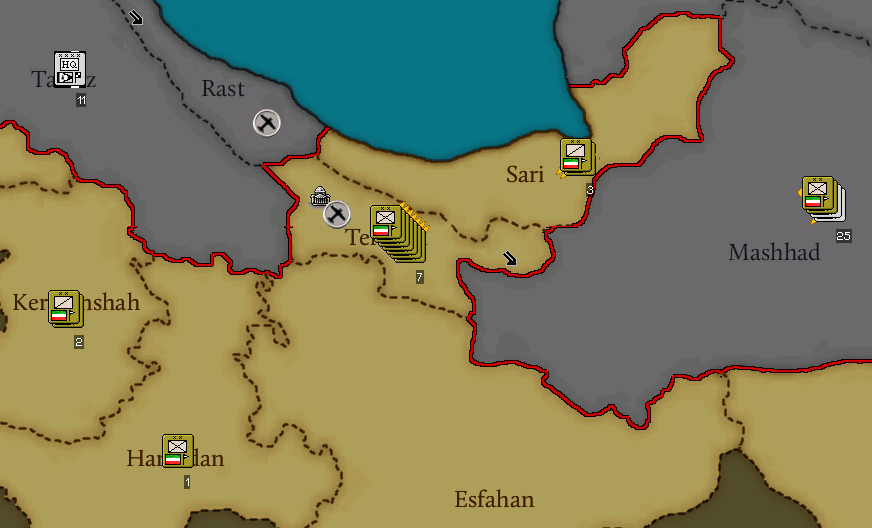 The operation meant Tehran was under threat from two directions before the Persians even had a chance to regroup from the initial defeat. 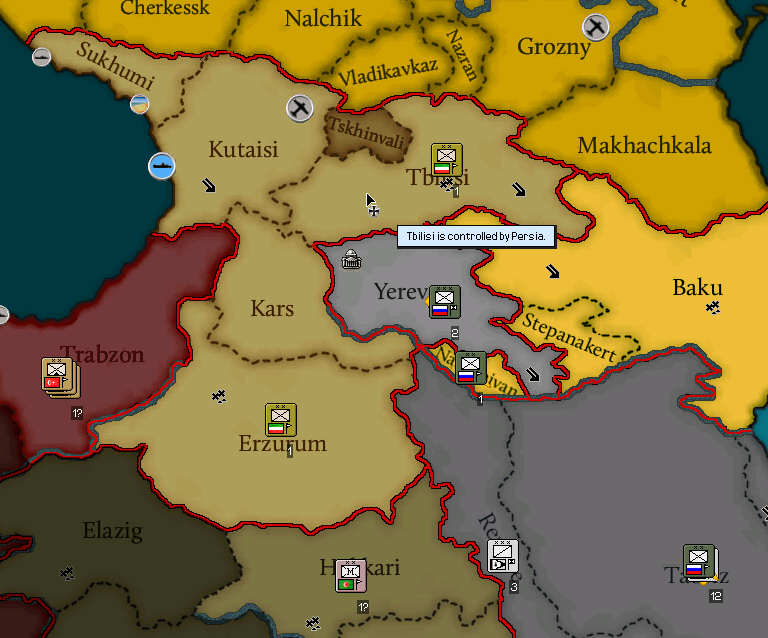 Some divisions did manage to sneak through Armenia and rampage through Georgia, much to the Khan's embarrassment. 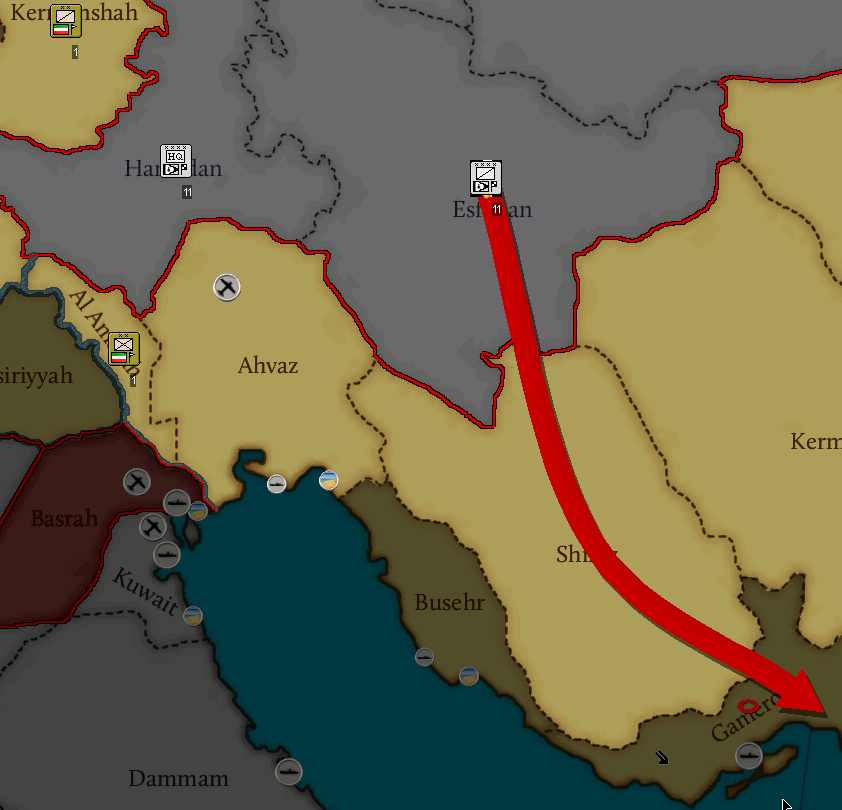 Tehran and the interior fell, and now the push to the Persian Gulf began. 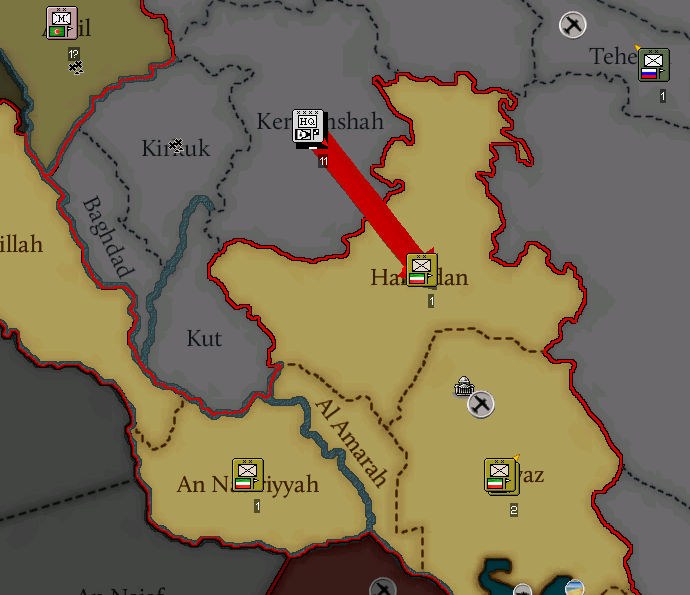 Persia had secured Iraq from the defunct Ottoman Empire and Mongol units captured Baghdad for the second time. The city had never recovered from the siege of 1258 and the Khan was not blind to the significance of capturing it for the Mongols once again. He had nothing against the city but ordered it sacked anyway, if only to provide an excellent propaganda opportunity. The new Khanate was following the footsteps of the old.  The Persians were unable to mount an effective defense anywhere, due to the qualitative and quantitative superiority of the Mongols. 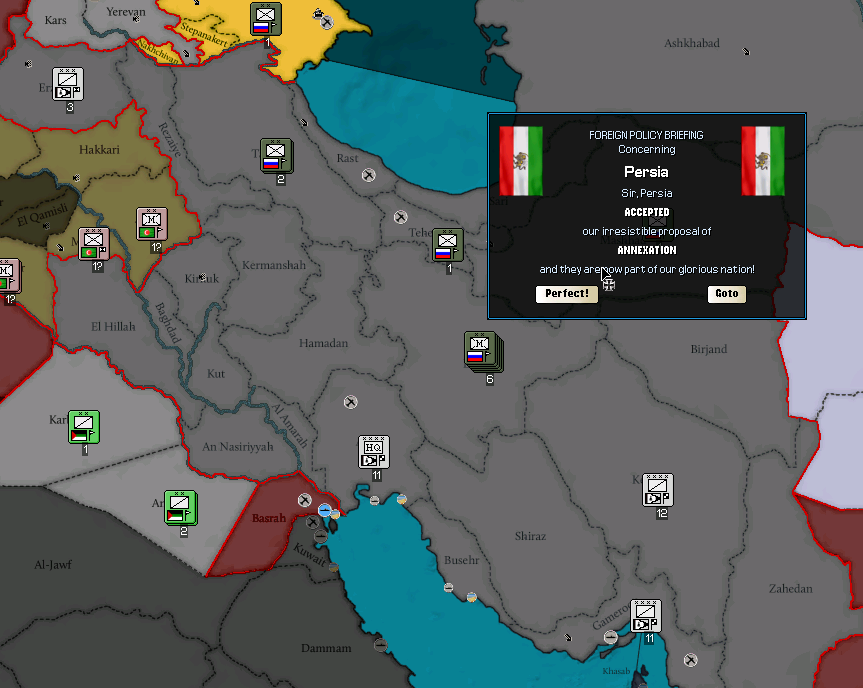 The Shah surrendered and went into exile. Persia was once again a Mongol subject. 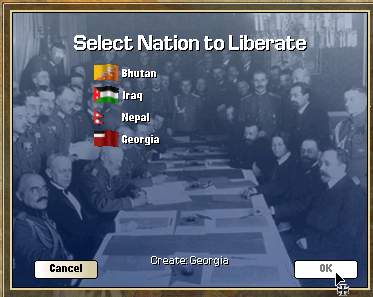 The Khan did have to reestablish his Georgian puppet. Hopefully they would be able to build a local defense force before the next conflict. 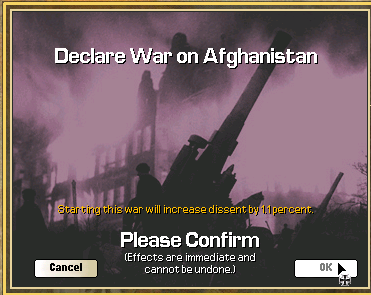 The next campaign was another out of the history books. Afghanistan had once been part of the Khanate, and it would be again.  The kingdom was weakened from its defeat by Delhi, beaten back to what had once been the border with the British Raj. 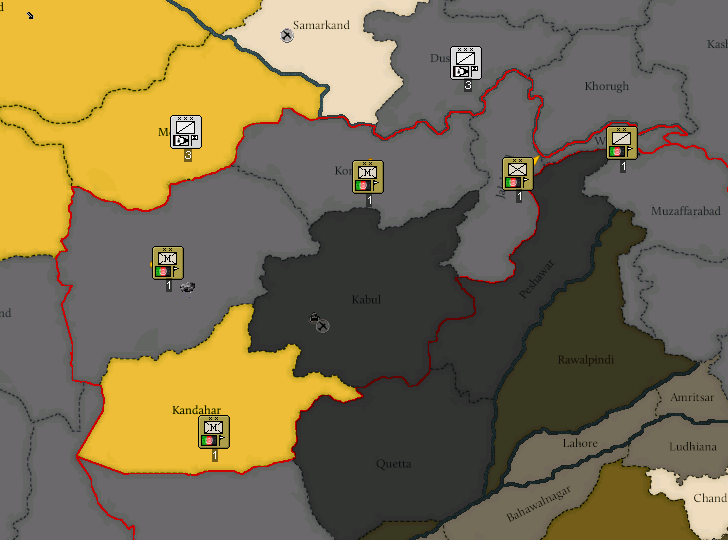 The terrain was also legendarily difficult. The British may have faltered due to this, but the Mongols had experience with rough terrain.  The Mongols attacked with a relatively light force, only nine divisions. They came up against outdated infantry and tribal militias that were not willing to fight hard for the King. 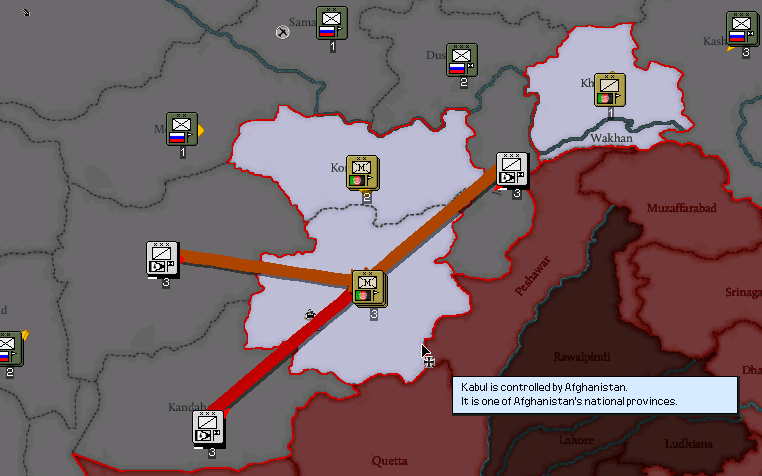 Kabul was quickly encircled. 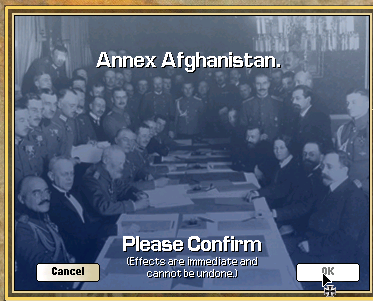 Afghanistan surrendered after the Mongols more or less galloped directly into the capital. 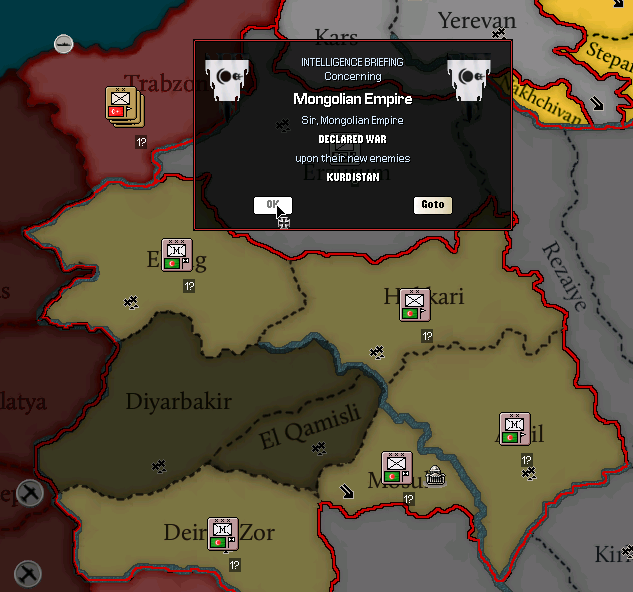 Another landlocked and recently free people, the Kurds, would be next. 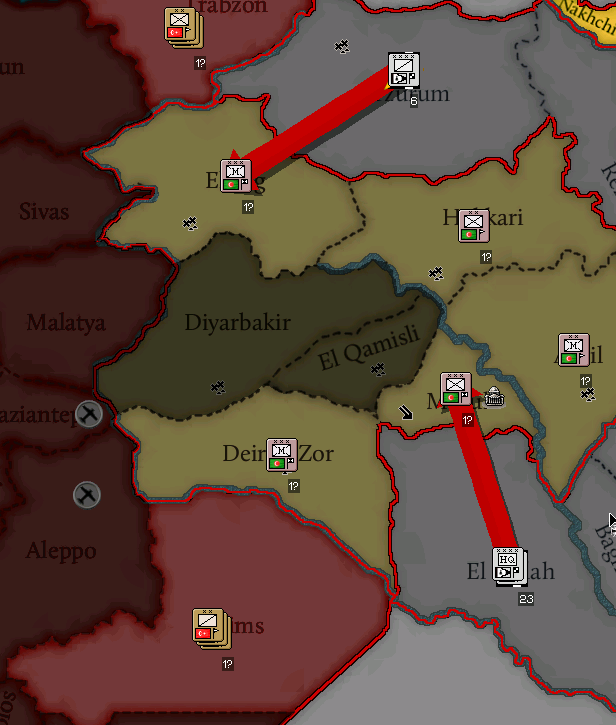 The nation had only managed to secure its independence due to the republican revolts and Arab conflict in the Ottoman Empire. It would not resist a true army. 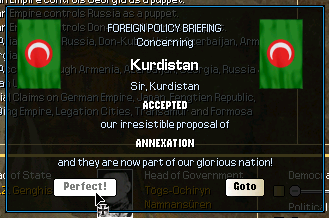 The stage was set for a conquest that had alluded even the Khans of old.  The Mongols had pushed far into Anatolia when it was the property of the Eastern Roman Empire, but were stopped short of Constantinople. The Khan was obsessed with the city, even if its prevalence had fallen far from when it was truly the Second Rome. 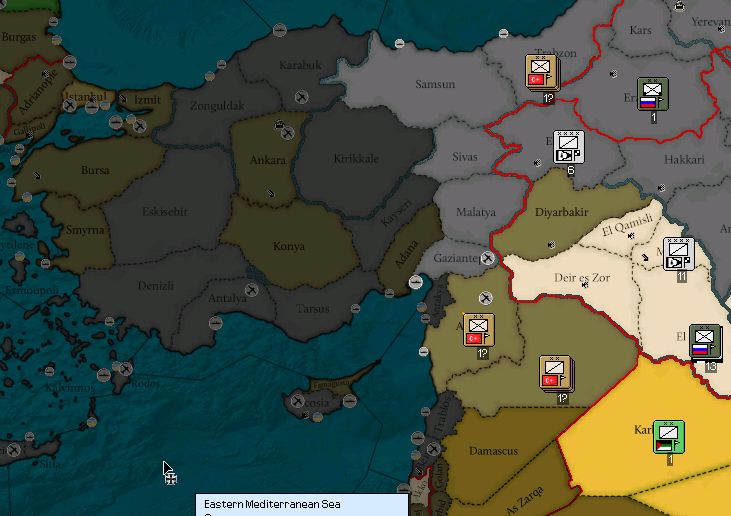 The terrain of Anatolia helped the defenders of old. It was mountainous and rough. 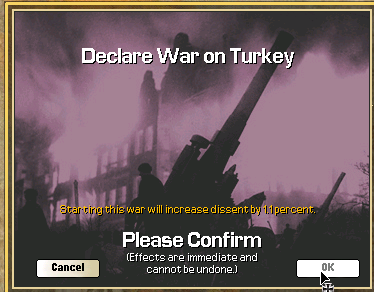 That wouldn't be a problem. 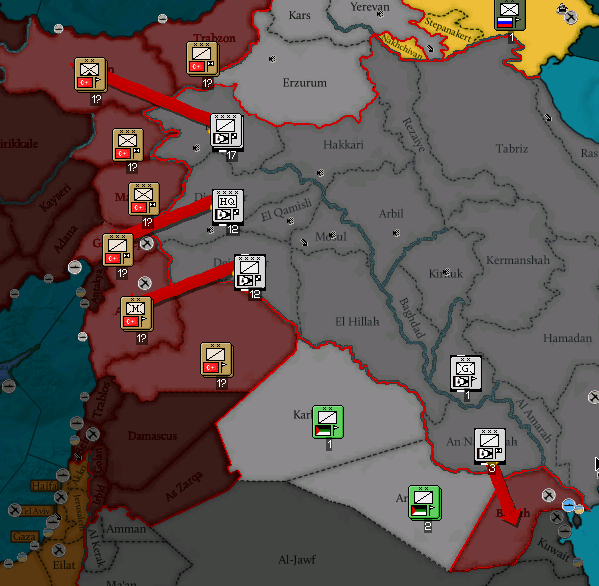 The Mongols had a specific plan of advance. The Kurdish territory provided an advance position from which the Mongols could capture Aleppo and Gazientep to cut off Syria and Lebanon from Turkey proper. 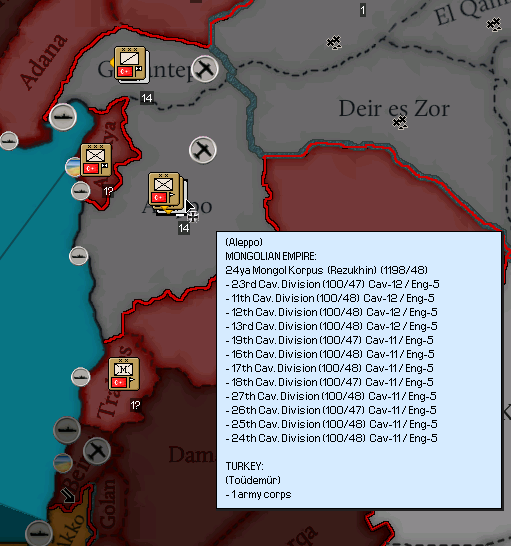 This created a small pocket along the coast between the two cities, which was promptly destroyed. 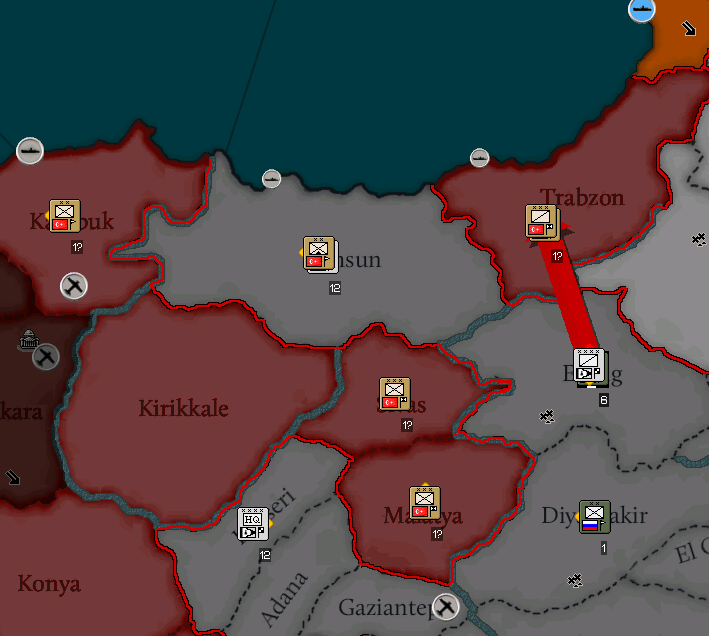 In Anatolia, the Mongols had marched directly to the Black Sea from Kurdistan, trapping a number of Turkish divisions in Trabzon and leaving others in a precarious situation. 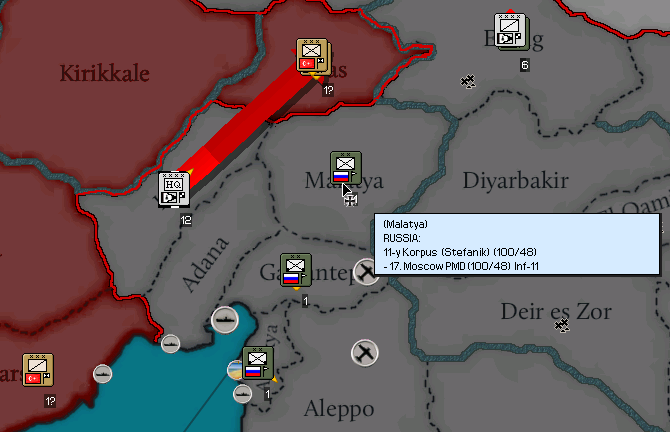 The Russian Grand Duke was eager to prove his worth to the Khan and provided a number of support units that cleaned up areas that the Mongol horsemen left behind. 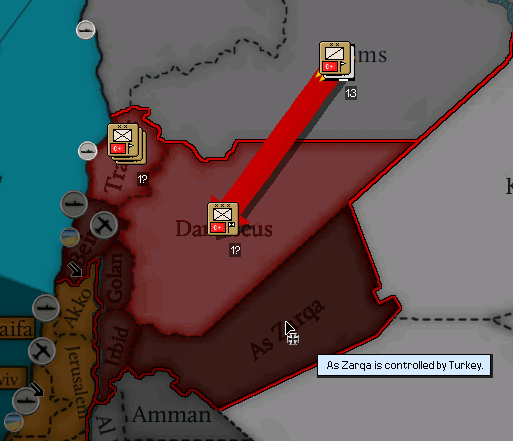 In Syria, the ancient city of Damascus was the main target. From Damascus, the Turkish forces in the Levantine theater could be dismantled. 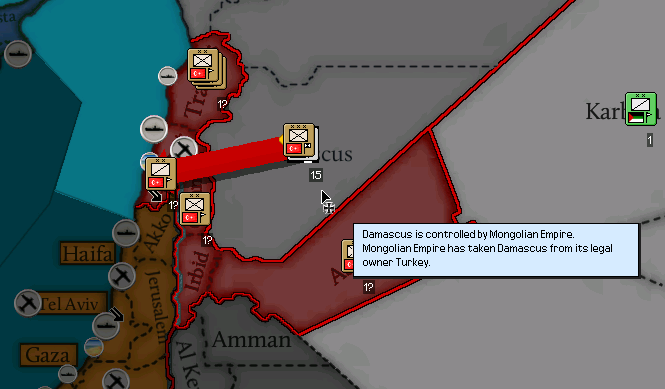 After capturing Damascus, Beirut was the next target. The plan was to trap and destroy Turkish divisions in northern Lebanon. 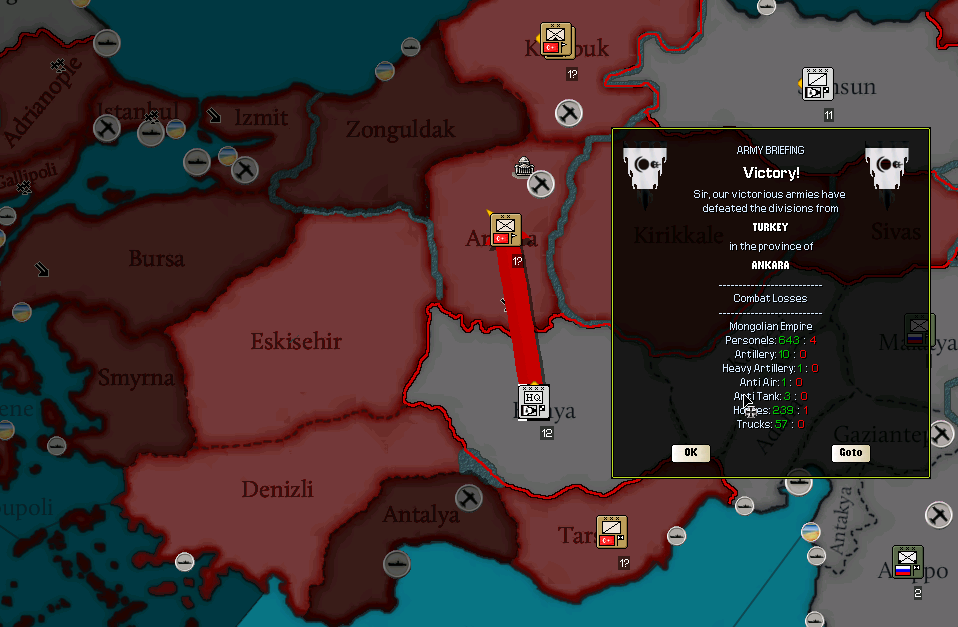 Turkish forces on both fronts were unable to mount a resistance. The Turkish republican Kemal had moved the capital to Ankara, and its defenders were evicted with ease. 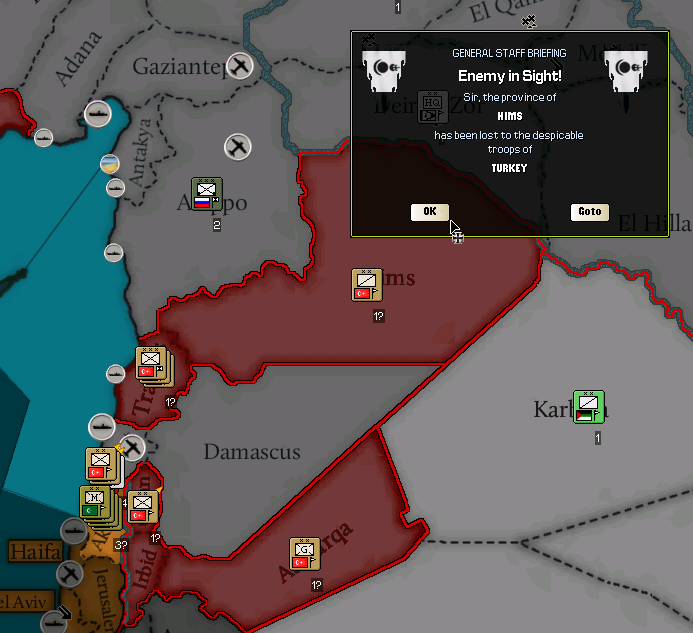 The southern Turkish divisions showed some signs of life, moving to cut off the Mongol horde that had penetrated deep to Lebanon. 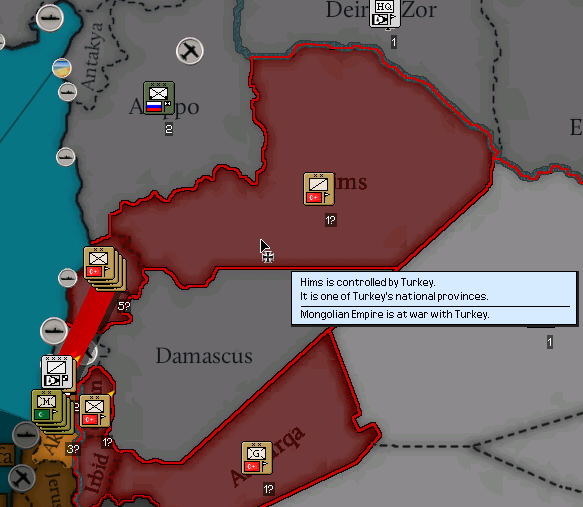 In order to escape, the Mongol horde had to fight its way up the coast against what was likely the largest remaining Turkish army in the southern sector. 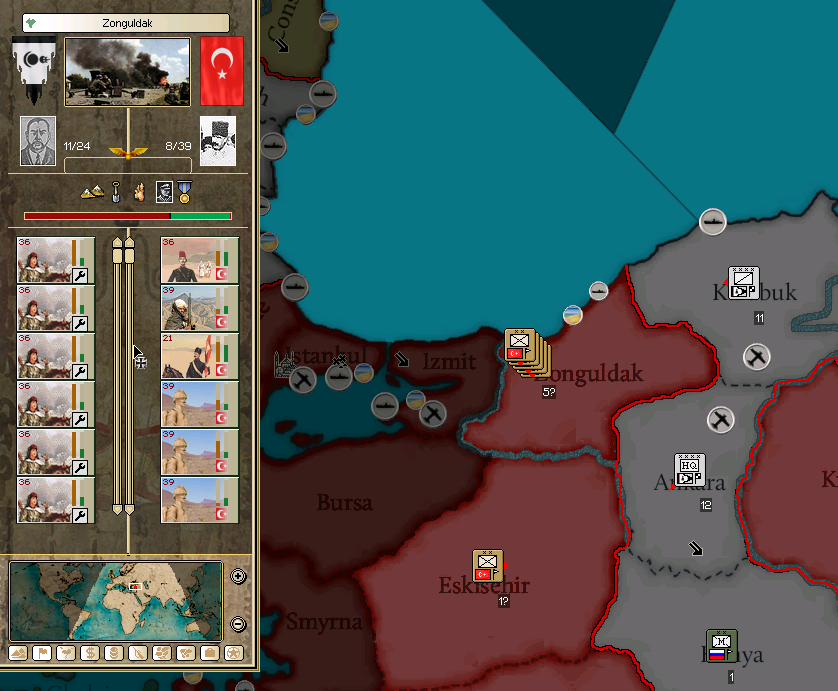 The Turks also began to set up defenses in the hopes of preventing the capture of Istanbul. They were understrength and disorganized and could not do much to prevent what was increasingly inevitable. 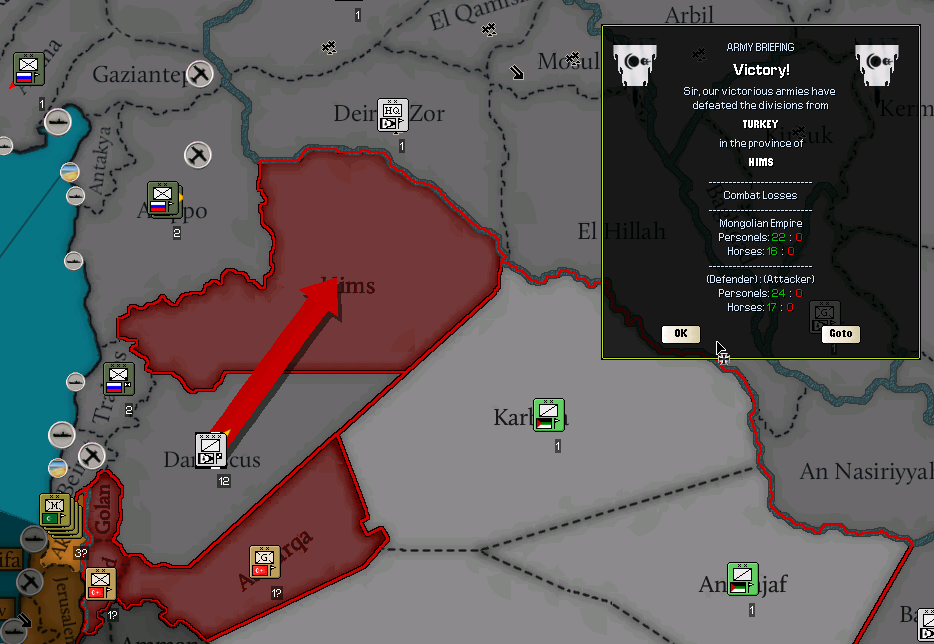 Once again the Russians came to the aid of their masters, securing the supply lines while the horde destroyed the army that had trapped it. 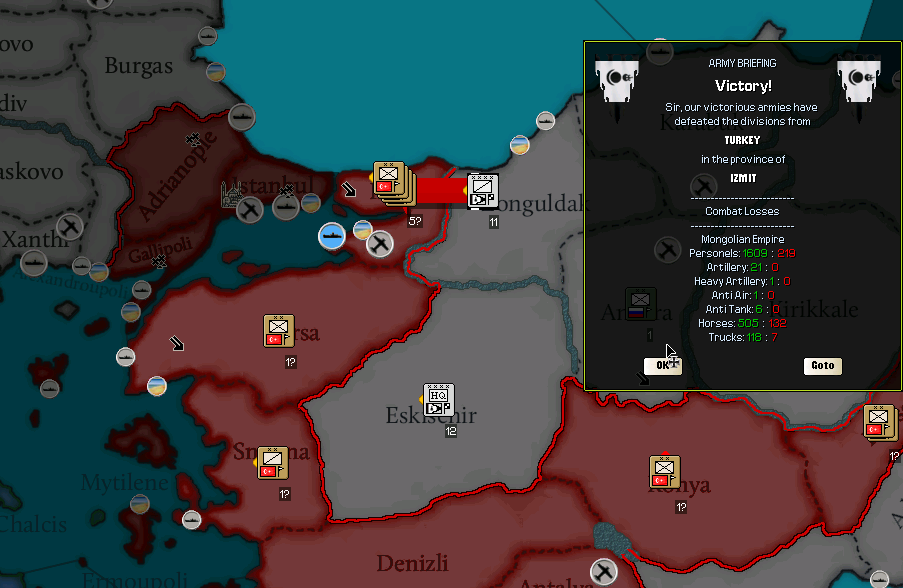 The road to Istanbul was littered with more Turkish dead, as their fighting retreat to reinforce Istanbul was continually caught and harried by the Mongol horsemen. 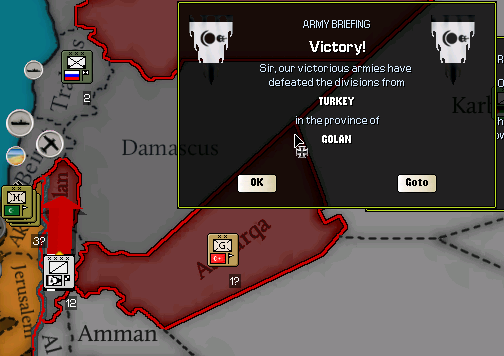 With the capture of Damascus and Beirut as well as the defeat of the major Turkish army in the Levant, the operation in Syria became a clean up, as units manning the tense border with Egyptian Palestine were trapped and destroyed by the Mongol advance. 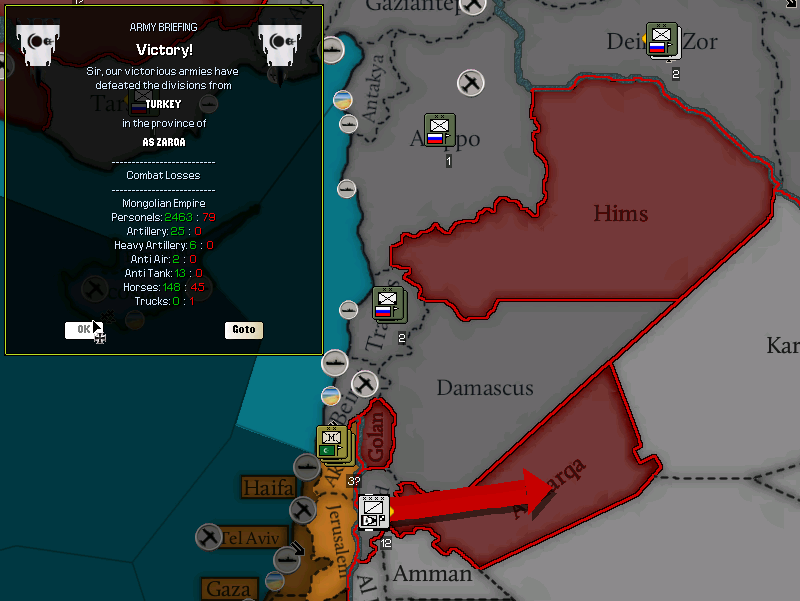 The desert outpost that monitored the Hashemites was also destroyed. 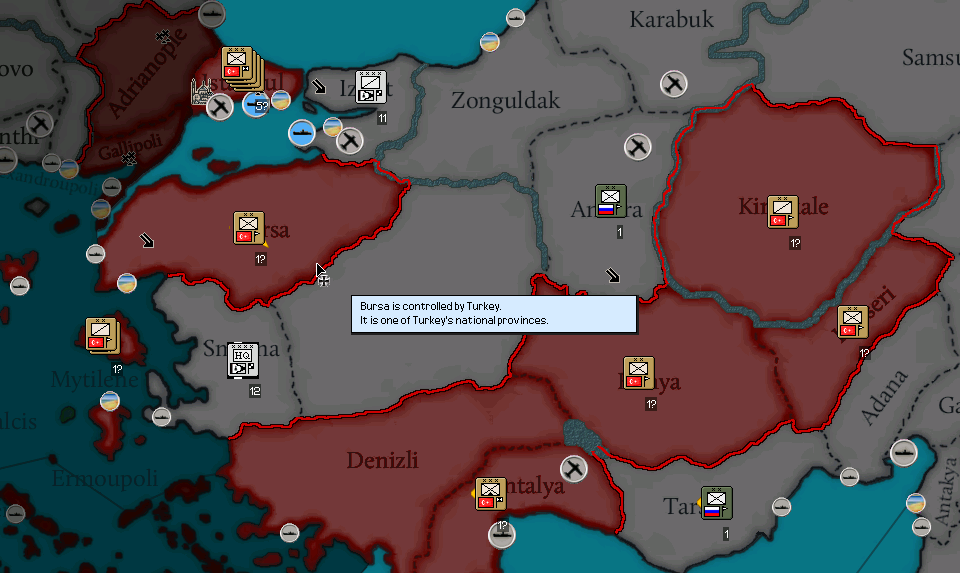 The Mongol advance was characteristic of what had brought them from Urga to Istanbul. They advanced far and fast, exposing their rear lines to attack with the goal of subduing the enemy before they could capitalize on the opportunities. The dangers of this approach were reduced by the presence of Russian infantry, who provided some measure of defense for the advancing hordes. 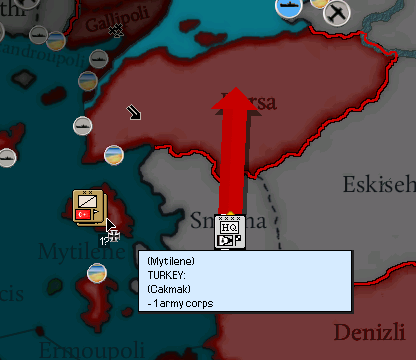 The capture of Smyrna and Izmit formed a pocket on the Asiatic side of the Bosphorus, which was destroyed quickly. The more interesting situation was the retreat of Turkish cavalry to the Aegean Islands. They could not be as easily pursued. 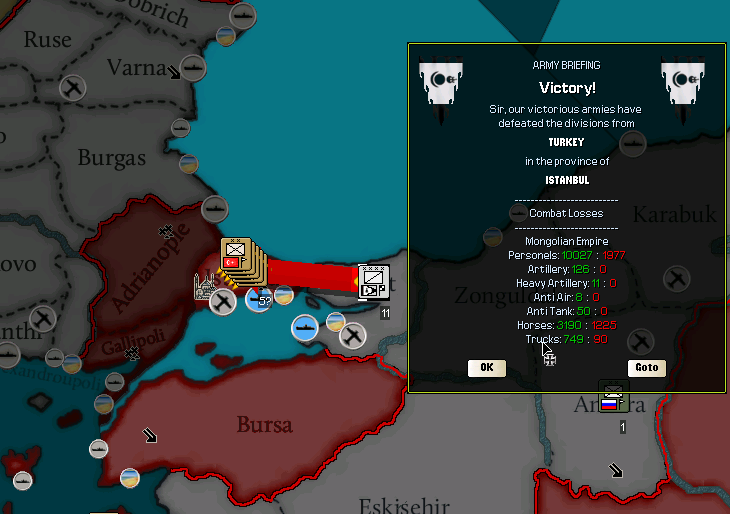 The Turks were exhausted from their long retreat. They did not give up their most famous of cities easily though, losing ten thousand men in a pitched battle across the straits. 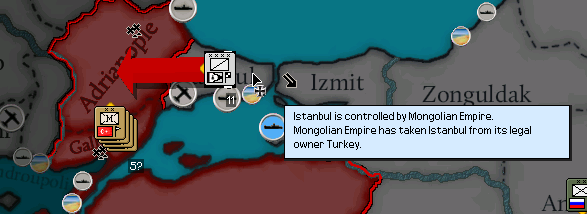 No death toll could have deterred the Khan from this achievement. The Mongols had not reached the shores of this famed city. It was around this time that the Khan began to wonder if he could not only match but exceed the Khans of old. 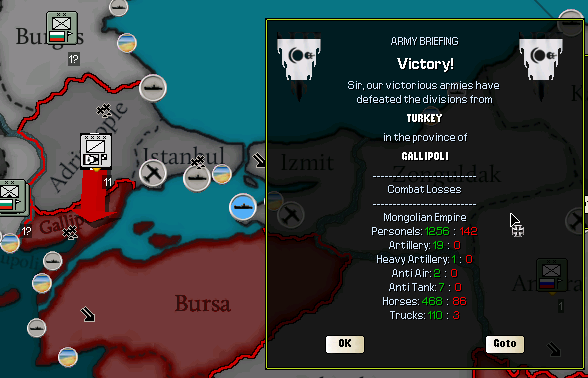 The Turks had abandoned their city and could not defend Adrianople either. They ended up, in one of history's great ironies, fighting to the death on the beaches of Gallipoli, with their backs to the sea. 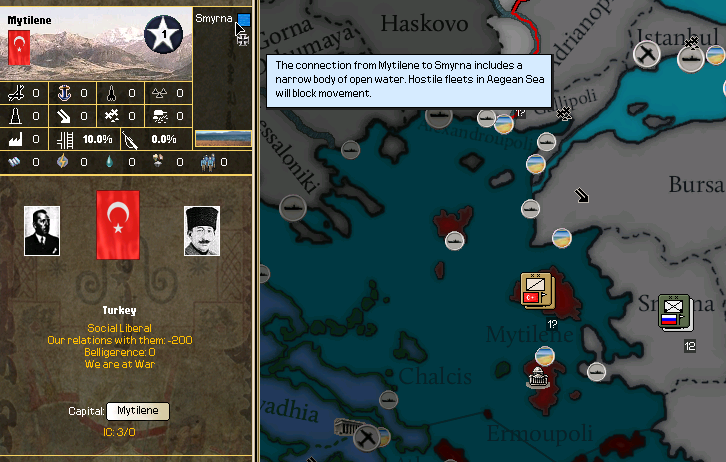 The Turks were stubborn and vowed to fight on from their Aegean outposts. Their navy was obsolete and not well regarded, but it was better than nothing, which is what Mongolia had. For all intents and purposes, Turkey was defeated, but they would have to be convinced in order to establish Mongolian supremacy. How the Mongols did it brought a revelation to the Khan, and another mad dream. In this modern age of technology, he truly could achieve what the Khans of old did not.
|
|
|
|
This is completely insane. Much like Ghengis-2.
|
|
|
|
We're going to need a lot of rafts.
|
|
|
|
paragon1 posted:We're going to need a lot of rafts.
|
|
|
|
How much industry can you muster up effectively from your empire at this stage?
|
|
|
|
Post a map of your Empire
|
|
|
|
Sleep of Bronze posted:How much industry can you muster up effectively from your empire at this stage? The Prince of Terror I appointed bumped me up to 77 base IC, which is about 110 effective IC. The PoT becomes necessary if you are playing a nation that doesn't get many cores. Twenty percent of foreign IC to thirty five is a big deal for conquerors. Plus it fits the theme. csm141 fucked around with this message at 08:04 on Dec 29, 2014 |
|
|
|
What is the rest of the world doing while the Mongols go apeshit on Asia, anyways? Like, are they all just looking at each other and shrugging, or are they prepping for war, or are they busy fighting each other, or what?
|
|
|
|

|
| # ? May 10, 2024 15:34 |
|
DivineCoffeeBinge posted:What is the rest of the world doing while the Mongols go apeshit on Asia, anyways? Like, are they all just looking at each other and shrugging, or are they prepping for war, or are they busy fighting each other, or what? The complete and utter collapse of the German Empire at the hands of the French Syndicalists might be distracting them.
|
|
|





